

15 Examples of Social Issues in Canada
Canada is the second-largest country in the world by land area. It’s home to over 38 million people, hundreds of languages, and some of the most beautiful natural landscapes. Like every nation, Canada has social issues related to climate change, the rights of marginalized people, gender equality, and healthcare. Here are fifteen examples:
#1. Climate change
In 2020, Canada was the 11th largest greenhouse gas emitter in the world. This represents a decrease from 2005, but Canada still has lots of work to do. It’s the top public financier of fossil fuels among G20 nations. It also consistently approves new oil and gas pipeline expansions and fails to enforce regulations that reduce emissions. According to Climate Action Tracker, the country’s climate goals aren’t enough to meet the Paris Agreement.
#2. Gender inequality
Canada ranks as one of the best countries for women. In 2023, it ranked in 30th place out of 146 countries on the Global Gender Gap Index Rating. Acts like the Canadian Human Rights Act, the Canadian Charter of Rights and Freedoms , and the Pay Equity Act establish the importance of gender equality. There are still gaps to close, however. According to Canadian Women, women still make just 89 cents to every dollar a man makes. In 2020, 10x more women than men left the workforce. Surveys show Canada’s ongoing commitment to gender equality, so the future looks promising.
#3. Immigration policy
Canada has welcomed immigrants for many years. Most people in the country have favorable views of immigrants, and according to a 2022 survey, less than 30% of Canadians thought immigration levels were “too high.” This doesn’t mean Canada does everything right. A 2021 Human Rights Watch report found that thousands of people were being incarcerated on immigration-related grounds. Despite being held for non-criminal reasons, immigrant detainees faced brutal conditions in maximum security jails and solitary confinement. Despite its good reputation regarding immigration, Canada has a lot of work to do.
#4. Indigenous rights
Canada has a long history of colonization and violence against Indigenous people. Reconciliation has been slow. According to an Amnesty International report, Canada has been “significantly failing in its obligations” to Indigenous people. Issues like territorial theft, resource extraction, systemic discrimination, and inequality are persistent. The Amnesty report echoes findings from the UN and other human rights organizations . You can learn more about indigenous rights by taking part in an online course .
#5. Violence against Indigenous women
Canada’s reputation as a safe place for women only applies to certain women. First Nations women and girls with registered or treaty Indian status make up 2-4% of Canada’s female population, but they’re kidnapped and assaulted at disproportionate rates. According to data from Human Rights Watch, 81% of Indigenous women in the child welfare system were physically or sexually assaulted. From 2001-2015, the homicide rate for Indigenous women was almost six times as high as the rate for other Canadian women.
#6. Gender-based violence
Gender-based violence includes physical violence, emotional abuse, stalking, manipulation, and so on. According to Canadian Women, 184 women and girls were killed (mostly by men) in 2022 . Women who’ve experienced gender-based violence are more likely to have depression, anxiety, and other mental health diagnoses. Children who witness violence are also more likely to struggle and experience mental health effects. Dealing with gender-based violence – specifically spousal violence – costs the Canadian government over $7 billion a year. While certain people are at a higher risk of gender-based violence, it can affect anyone.
#7. LGBTQ+ rights
Canada has long been praised as one of the most welcoming countries for the LGBTQ+ community. In 2023, it ranked first on the Equaldex Equality Index. Gay marriage was legalized first in British Columbia and Ontario in 2003, and in 2005, same-sex marriage became legal across Canada. The past decades have seen even more progress regarding anti-discrimination and anti-harassment laws, adoptions, blood donation laws, and more. In 2021, Canada banned conversion therapy , which is any service, treatment, or practice designed to “cure” or suppress a person’s sexual orientation, gender expression, or gender identity . The country still has work to do regarding trans rights, safety, and freedom.
#8. Anti-Black racism
While Canada may have had a smaller role in the Transatlantic Slave Trade compared to other nations, the legacy of slavery and anti-Black racism is still present in the country today. According to statistics, 41% of Black people in Canada experienced discrimination based on their skin color in 2019. Stores, restaurants, and banks were common places of discrimination, while Black respondents also reported discrimination by police. Another study found that Black Canadians in Toronto dealt with “ service deserts ,” which are areas with fewer safe, affordable, and effective healthcare and community services.
#9. Education inequality
Canada’s education system is well-respected around the world. Each of the 13 territories and provinces have their own system, although they must follow government standards. Students aged 6-18 years old must attend school. In recent years, tuition for secondary education has been increasing, especially for international students. There are also stark gender differences in STEM (science, technology, engineering, and mathematics). In 2017, women made up just 26% of new entrants in engineering, manufacturing, and construction, and 20% of the new entrants in information and communication technologies. Unequal government funding for Indigenous students has also been an issue for many years. Canada has been making slow progress on funding gaps.
#10. Water rights
The right to safe water is a human right, but in Canada, Indigenous people have faced persistent violations. Why? The federal government has had jurisdiction over Native lands for centuries. First Nations are owed certain protections, but federal neglect has led to issues with safe drinking water. In 2016, a Human Rights Watch report found that discrimination regarding water is a “legal fact” in Canada. While Canadians living off-reserve have enjoyed safe water, First Nations deal with contamination and long-term boil-water advisories . Solutions, which can include removing colonial-era laws, are urgently needed.
#11. Healthcare
Canada uses a publicly funded healthcare system. Instead of having one national plan, there are 13 territorial and provincial healthcare insurance plans. Through these plans, Canadians get free medically necessary hospital and physician services. This fragmented system has had problems over the years, but the COVID-19 pandemic exacerbated the cracks in the foundation. According to Reuters reporting, Canada’s healthcare system has strained to a “breaking point” with staffing shortages, closed emergency rooms, and increasingly long waiting times. Things won’t improve overnight, so Canada’s healthcare system will likely be a social issue for a long time.
#12. Mental health
In Canada, mental illness affects more than 6.7 million people. It’s a leading cause of disability, suicide, and other health issues. According to the Centre for Addiction and Mental Health, the economic burden of mental illness costs around $51 billion each year . Funding and access are major issues. Just half of Canadians who experience a major depressive episode get “potentially adequate care.” ⅓ of Canadians 15 years and older report a need for mental care, but say their needs weren’t met. 75% of kids with mental disorders can’t access specialized treatment at all. These statistics expose a striking gap between need and care.
#13. Opioid crisis
Opioid addiction and overdoses have been an issue for several years in Canada. In 2016, more than 30,000 people died from opioid-related overdoses, which was more than other major accidental death causes combined. A 2022 NPR article reported that deaths related to fentanyl more than doubled in the past five years. British Columbia has endured the most issues and declared fentanyl a public health crisis in 2016. In 2022, the province instituted a decriminalization policy . Under this policy, possessing small amounts of opioids, cocaine, and methamphetamines remains illegal, but no longer comes with prosecution. Canadian officials hope this shifts focus to healthcare instead of punishment.
#14. Income inequality
Income inequality refers to the gap between those with the highest incomes in society and those with the lowest. Wide gaps lead to a host of issues such as political instability, reduced economic growth, and weakened social cohesion. In Canada, income inequality has been on the rise. According to data, the gap in net worth between the richest and poorest households grew by 1.1 percentage points in the first quarter of 2023. That represents the fastest increase since 2010. The reasons for this increase are complex. Relevant factors include low wages and growing gaps between different types of households, like younger and older households, and immigrants and Canadian citizens.
#15. Housing affordability
Having a place to live is a human right , but when housing becomes expensive, many people struggle to find adequate shelter. Canada is facing a housing crisis. According to a BBC article, the average home in Canada costs C$750,000 in 2023 , which is around £435,000. That’s an increase of 360% from 2000. The cost of houses and rent is especially high in large cities. Young people, who are spending huge chunks of their incomes just on shelter, are changing their life plans because of the crisis. Canada has promised to build 3.5 million homes by 2030 to address the issue, but plans are falling behind. The housing crisis is unlikely to get resolved anytime soon.
You may also like

15 Great Charities to Donate to in 2024

15 Quotes Exposing Injustice in Society

14 Trusted Charities Helping Civilians in Palestine

The Great Migration: History, Causes and Facts

Social Change 101: Meaning, Examples, Learning Opportunities

Rosa Parks: Biography, Quotes, Impact

Top 20 Issues Women Are Facing Today

Top 20 Issues Children Are Facing Today

15 Root Causes of Climate Change

15 Facts about Rosa Parks

Abolitionist Movement: History, Main Ideas, and Activism Today

The Biggest 15 NGOs in the UK
About the author, emmaline soken-huberty.
Emmaline Soken-Huberty is a freelance writer based in Portland, Oregon. She started to become interested in human rights while attending college, eventually getting a concentration in human rights and humanitarianism. LGBTQ+ rights, women’s rights, and climate change are of special concern to her. In her spare time, she can be found reading or enjoying Oregon’s natural beauty with her husband and dog.
Social Issues in Canada
In recent years, one of the most defining elements of the Canadian identity has been the country’s social policies — the collection of laws and regulations that govern how Canadians live their lives, and what sorts of individual rights the government is willing to protect and defend.
Given that many Canadians like to focus on how their country is different from the United States, social policy is often seen as a window into the sort of values that make Canada a uniquely progressive country — though it would be a mistake to suggest all social policy is progressive or that progressive social policy has no Canadian critics.

The politics of health care
In the 2001 Canadian federal election, Stockwell Day (b. 1950), the conservative candidate for prime minister, famously brandished this sign during a televised debate, lest anyone think he was soft on the issue of privatizing health care. Conservative politicians are often on the defensive about health care policy, since many conservative intellectuals and commentators would like to see more privatization in the system, yet these ideas are not considered popular with voters.
Canadian Health Care
Whenever Canadians are polled about what makes them “proudest to be Canadian,” the Canadian health care system often tops the list. Beginning in the 1960s, Canada’s provincial governments began introducing government health insurance (sometimes known as medicare ), to pay for hospital visits, operations, and other essential medical services. In 1984 the federal government passed the Canada Health Act which forced all provincial health plans to meet certain standards of coverage, and outlawed charging fees for medically-necessary services. Today, all Canadians are provided with comprehensive health insurance from birth through public health plans run by the various provincial governments (with funding help from Ottawa). The provincial governments now generally run most hospitals and clinics as well, with doctors and surgeons charging governments directly for their services. Very few privately-run hospitals or clinics exist in Canada these days.
- Canada Health Act — Frequently Asked Questions, Health Canada
Canada’s public health care system is one of the most generous in the world, but also quite expensive to maintain. In recent years, many provincial governments have started to scale back their scope of insurance coverage in order to make their medicare programs more financially sustainable, and Canadians often purchase supplementary private health insurance to pay for things like dentist trips, eye exams and any operation or treatment the government considers “non-essential.” Such plans, sometimes called extended medical coverage are often provided to working Canadians by their employers as a perk of the job. Private health insurance cannot — by law — pay for services covered by a provincial, public health plan, however.
How to guarantee the long-term “survival” of the Canadian health care regime is one of the most heated debates in contemporary Canadian politics. On the right, it’s common to advocate greater privatization of medical services, including more privately-run, fee-based clinics and surgeons to give more choice to patients. Folks on the left, in turn, are generally extremely critical of anything that smacks of edging towards a so-called “ two-tiered ” system, where Canadians with money can buy their way into better medical care than those who use the public system. To the broader public, however, the status quo is considered nearly sacred, which leads most politicians to shy away from proposing dramatic reforms.
- Canada’s Health Care System, a summary from Health Canada
- Profile of the Canadian Health Care system, the Commonwealth Fund
- Canadian Health Care myths and facts, Snopes

Born in Poland to a Jewish family, Dr. Morgentaler survived death in a concentration camp and was a frustratingly complex foe for pro-life groups. Brash and outspoken, he is easily one of the most controversial Canadians of all time.
Abortion Laws in Canada
Owing in part to the pressures of the country’s large Catholic population , abortions in Canada were banned entirely until 1969, and then only permitted under narrow conditions when the mother’s health could be proven to be in danger. Illegal abortions continued in the background, however, and in 1988, a particularly unapologetic abortion surgeon named Dr. Henry Morgentaler (1923-2013) went before the Supreme Court of Canada to face charges. Siding with Morgentaler, the court ruled the country’s existing abortion regulations represented an unconstitutional burden on the rights of women, and the legal restrictions on the procedure were struck down.
Though the Supreme Court’s ruling said it would be permissible for the government to place some limitations on abortion, no Canadian government ever has. Canadian women thus have a universal right to abort at any stage of pregnancy — even the final weeks — which is a degree of permissiveness largely unseen elsewhere in the western world. At the same time, however, there do exist some de facto limitations on abortion determined by the ethics of individual doctors. In many parts of the country it can be difficult to find doctors willing to perform so-called late term abortions .
Abortion is a very controversial topic in contemporary Canada, and tops the list of things to avoid discussing in polite company. There are a number of passionate pro-life and pro-choice activist groups all over the country, prone to staging aggressive demonstrations and protests in order to ensure their opinions are heard. All of Canada’s political parties are officially pro-choice, however, and proposals to change Canadian abortion policy are almost never heard in mainstream political discussion. Since the 1990s, there has been a strong consensus among Canada’s party leaders that the “ abortion debate ” is a topic too politically explosive to reopen, so the status quo stays. This political consensus masks the degree Canadians themselves disagree about the issue however — a 2018 poll found Canadians quite evenly split when it was asked whether “there should be laws on abortion in Canada.”
- Abortion in Canada Timeline, AbortioninCanada.ca (pro-life)
- Abortion Rights Coalition of Canada (pro-choice)
- Induced Abortions Reported in Canada in 2014, Canadian Institute for Health Information (spreadsheet file)

A medical marijuana store in downtown Toronto. Though many such stores are not actually licensed medical retailers, police in big cities rarely enforce such laws, allowing them to operate in a state of immunity.
Drugs and Alcohol
Liquor was associated with all sorts of social ills in early Canada, and at various times during the early 20th century most provinces experimented with banning the sale and production of alcohol in various ways. This era of so-called prohibition was not the magical solution many had hoped for, however, and by the 1920s, most provinces had changed their laws to re-allow the sale of alcohol, but only within certain tight regulations. To this day, Canadian provinces will often have complicated rules governing just how or where booze can be sold; in some provinces it may only be sold by special government-run liquor stores, in others the law may require hard alcohol and beer to be sold at different locations. Almost all forbid the sale of liquor at 24-hour shops like supermarkets and corner stores. Provinces generally allow citizens to brew (but not sell) their own beer and wine, but it is against federal law to make distilled liquor without a permit.
Canada’s legal drinking age is set by the provinces. In Alberta, Manitoba and Quebec the age is 18 , everywhere else it is 19 . Most provinces also have strict laws against consuming alcohol in public places and low standards for what constitutes “ driving while under the influence .”
Marijuana was legalized for personal consumption across Canada in the fall of 2018. In theory, there are a lot of strict laws dictating exactly when, where and how marijuana can be bought, sold, and used, but it’s unclear to what degree these rules will be enforced. Prior to 2018, Canada’s anti-pot laws were rarely enforced and offenders rarely faced serious punishment, particularly in big cities. Since 2001, it has been legal for Canadian doctors to prescribe marijuana for medical reasons , and in 2014 the federal government authorized the licensing of private retail distribution of medicinal marijuana — a decision which triggered a dramatic increase of pot shops in urban centres, most of which promote rather hazy definitions of “medically necessary” pot.
Hard drugs like heroin, cocaine, LSD, and meth are all banned in Canada.
- Cannabis in Canada: Get the Facts, Government of Canada
- Cannabis for Medical Purposes, Health Canada
- Health Labels for Cigarettes and Little Cigars, Government of Canada
A few works that have been banned from Canada
- "Love to Hate" by the People Haters (CD)
- "Blondes in Bondage" (DVD)
- "Kill the White Man" (DVD)
- "Super Erotic Manga Anthology, Vol. 91" (Book)
- "Family Lust" (magazine)
- "Fight Crime: Abort Black Babies" (sticker)
- "Bestiality Girlfriend Catalog" (comic book)
- "The Jew World Order Unmasked" (essay)
Freedom of Speech in Canada
Canadians generally take their constitutionally-protected right to free expression (the freedom to say or write whatever you want) very seriously, but the privilege is not an absolute one. As discussed in the Canadian Constitution chapter, Canada’s Charter of Rights and Freedoms allows “reasonable limits” to be placed on most civil rights, and over the years the government has used this authority to pass some legal limits on freedom of speech. Canada has relatively uncontroversial laws that forbid spreading deliberate, malicious lies about other people (known as slander or libel ) as well as copying or attempting to profit from other people’s ideas ( copyright infringement ). It is also generally against the law to use speech to encourage, advise, or provoke the committing of crimes.
It is still technically illegal to sell or produce obscene material in Canada and the Canadian government often bans the import of specific magazines, books, comics, containing very extreme depictions of sexual violence or perverted sex acts like incest or pedophilia. More “mainstream” pornography is only available in specially licensed stores or theaters, though this has obviously become far less relevant in the internet age. Provincial governments have similar laws banning children from buying pornography, excessively violent video games, or tickets for movies with “mature” content
- Canada Border Services Agency’s Policy on the Classification of Obscene Material
- Movie Ratings in Canada, Parent Previews
Canada has hate speech laws that make it a crime to publicly incite “hatred against any identifiable group” such as racial, religious, or sexual minorities, through written statements or other forms of media. There are exemptions for matters of sincere opinion or religious belief, and the attorney general of Canada must generally choose to initiate prosecution. More sweeping laws that made it a crime to “expose a person or persons to hatred or contempt” on the basis of identity were abolished in 2014. Sentences for the most extreme forms of hate speech, particularly hate speech that “promotes genocide,” can reach a maximum of two to five years in prison. New national security legislation makes it a crime to distribute media that “advocates or promotes” terrorism, as well.
- When is it hate speech?: 7 significant Canadian cases, CBC

It's against the law to own a "replica firearm" in Canada, which the law defines as "any device that is designed or intended to exactly resemble, or to resemble with near precision, a firearm." In order to avoid breaking the law, toy guns, paintball guns, and other play weapons are often cartoonishly proportioned and have bright orange muzzles.
Guns in Canada
As a country with long traditions of hunting and trapping, Canada’s rate of gun ownership has historically been high, and Canada has some of the most liberal gun laws on earth. According to the Canadian National Firearms Association , there are presently about 21 million guns in Canada owned by about seven million Canadians — or about 20 per cent of the population — the majority of whom are recreational hunters. The most commonly owned guns in Canada are rifles and shotguns.
The Canadian government requires citizens to pass a safety course and undergo a background check before they can get a firearms Possession and Acquisition Licence ( PAL ) to legally own or buy arms, and laws governing gun storage and transportation are detailed and strict. Unlike most countries, Canada does not have national gun registry, though handgun owners must obtain a registration certificate to prove they are a legal owner. The government maintains a long list of banned guns , mostly semi-automatic rifles, though they can be rented for use in shooting ranges.
Gun control in Canada has proven to be an issue which sharply divides the country in terms of rural-versus-urban. For those who live in big cities, guns tend to be associated with inner-city crime, particularly gangland murders, and support to severely control or outright ban gun possession is usually high. Canadians who live in more rural parts of the country, in contrast, usually associate guns with hobbies like hunting, sport shooting and collecting, and see gun control as an undue burden that punishes the otherwise law-abiding.
- Frequently Asked Questions Canadian Firearms Program, RCMP
- Canadian Coalition for Gun Control
Discrimination Protections
Canada has a fairly robust set of legal protections designed to prevent Canadians from being discriminated against on the basis of things they can’t control, such as race , gender , religion , or sexual orientation .
The Canadian Charter of Rights and Freedoms is a section of the Canadian Constitution that makes it illegal for the government of Canada, or any provincial government to pass laws that either explicitly discriminate against certain Canadians on the basis of their identity, or simply place an unfair burden on one group over another. The Supreme Court of Canada routinely overturns laws they perceive to be discriminatory on the grounds of Charter protections.
Canada also has a sweeping piece of legislation called the Canadian Human Rights Act that forbids private entities, such as employers, landlords, schools, and stores from discriminating against clients or customers on the basis of identity. Discrimination cases of these sorts are investigated by the Canadian Human Rights Commission and adjudicated by a court-like body known as the Canadian Human Rights Tribunal that has the power to issue fines and or other corrective actions. The various provincial governments have their own human rights laws, commissions, and tribunals as well.
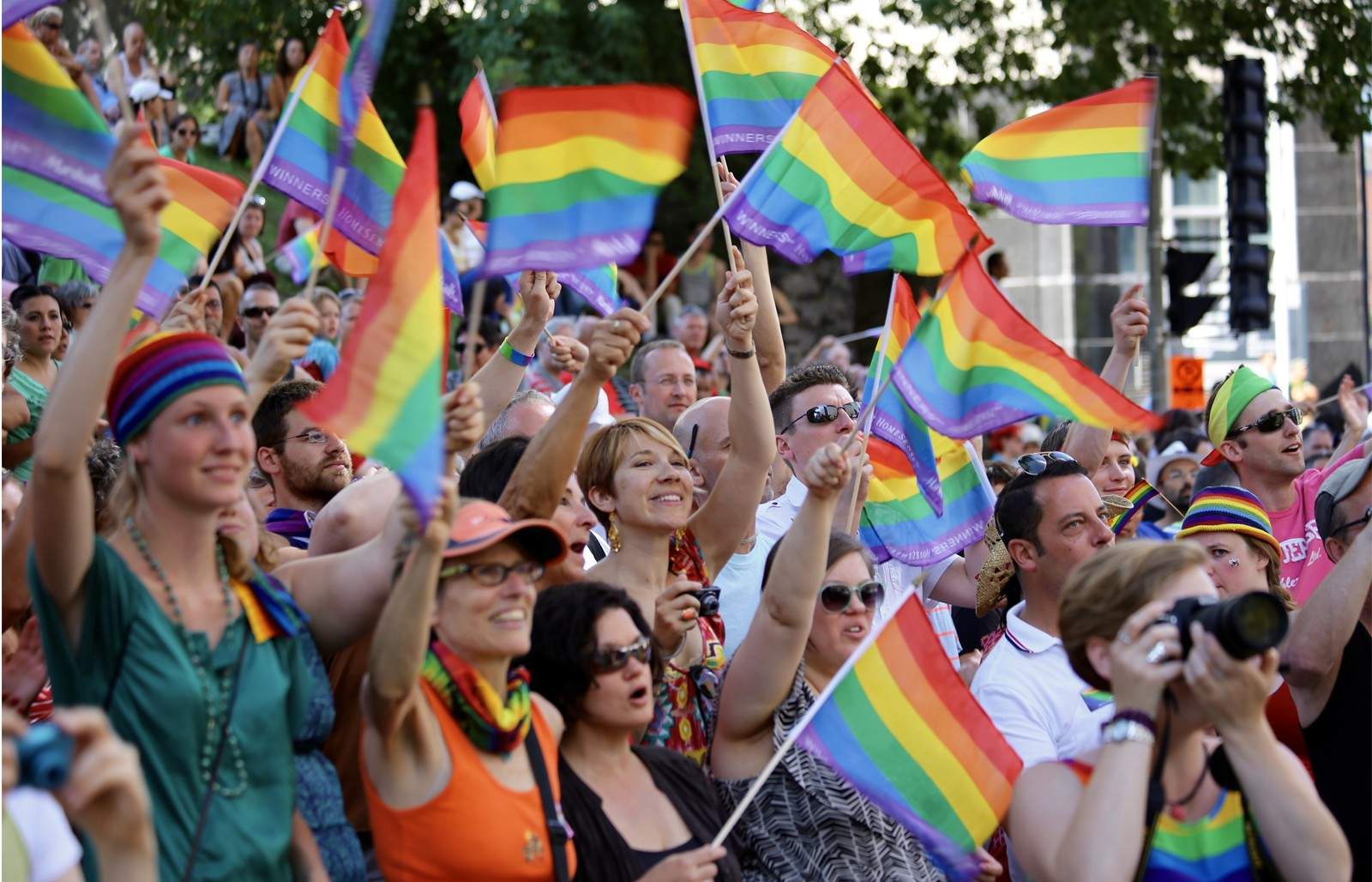
Cheering Montreal's 2013 Pride Parade. Paul Vance/Shutterstock
While "LGBT" remains the most common acronym to describe the community of Canadians with non-traditional sexual and gender identities, some activist groups include the number 2 in the acronym as well (LGBT2). This refers to the idea of being "Two-Spirited," which is the term some aboriginal Canadian cultures use to describe LGBT-type people.
Lesbian, Gay, Bisexual, and Transgender Rights
Canadians’ attitudes towards same-sex relationships have greatly liberalized over the last couple decades. Beginning in 1969, most legal bans on “ sodomy ” were lifted, and since then, more and more Canadians have been comfortable living “out” lives as open homosexuals. Provincial governments now explicitly prohibit discrimination in employment or housing on the basis of sexual orientation, and the Supreme Court of Canada has ruled that it is constitutional to impose fines or bans on those who spread aggressively anti-gay “hate speech.” At the same time, homosexuality can still be an issue that makes some Canadians uncomfortable. Many gay or lesbians may experience tension with their families in the aftermath of “coming out” (particularly in more rural or religious parts of the country), and many same-sex couples may not be comfortable showing affection in public, with the exception of known “gay-friendly” venues or neighbourhoods.
After years of opposition from both major parties, in 2005 same-sex marriage was legalized in Canada when the short-lived government of Prime Minister Paul Martin (b. 1938) passed the Civil Marriage Act , which redefined marriage as simply a “lawful union of two persons.” The law was opposed, and continues to be opposed, by many Christian groups and political conservatives, but in 2016 the Conservative Party formally abandoned its promise to reverse the legislation.
Transgenderism , or being born into a biological sex that does not match one’s psychological gender identity has only very recently become a matter of mainstream attention in Canada, and it remains a topic that is far more controversial and contested than homosexuality. All provincial health plans recognize gender dysmorphia — the medical name for the state of being transgender — as a valid medical condition, and will cover the costs of sex reassignment surgery (also known as gender-confirming surgery ). That said, there are almost no surgeons in Canada who actually perform the procedure, and many trans Canadians must travel abroad — and often pay out of pocket — to have it performed. Many Canadians may be hostile or skeptical of transgender people, though there is also growing acceptance of trans people as a legitimate minority deserving of public compassion and legal protection.
- Egale, Canada’s largest LGBT lobby group
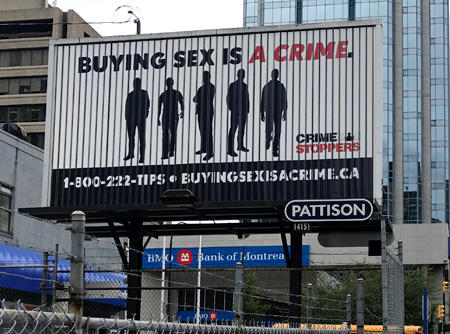
A billboard in downtown Vancouver reminds men of Canada's prostitution laws.
Prostitution
Selling sex is legal in Canada, but purchasing it is not, a somewhat confusing status quo born from a 2013 Supreme Court ruling holding that previous attempts to outlaw selling represented an undue burden on the safety rights of prostitutes.
Canada’s new prostitution laws, passed in 2014, impose tight regulations on precisely how sex can be sold and advertised — generally as far from public view as possible, and only by the prostitute herself (as opposed to a pimp, madam, or brothel).
Prostitution is incredibly stigmatized in Canada, and sex work is considered an incredibly dangerous and offensive job. Many Canadian prostitutes are poor women (and to a lesser extent, gay men) who come from some of society’s most marginalized groups, such as drug addicts, refugees, or aboriginal Canadians . Despite laws forbidding it, many prostitutes are likewise trapped in exploitive relationships with their managers that are both physically and economically abusive. In recent years, it has been more common to see charitable groups in large Canadian cities that actively work to improve the conditions of sex workers, though this has also faced controversy for “normalizing” prostitution.

The massive Casino de Montreal in Quebec is Canada's largest casino, and one of the largest on earth.
Gambling in Canada
First legalized in 1969, government-run gambling underwent a dramatic boom in Canada during the 1980s and 1990s, largely as a way for provinces to increase their budget revenues without raising taxes. All provinces are now home to a wide variety of legal games of chance, including slot machines , casinos , sports bookies , animal racing , and video lottery terminals (or “ VLTs ”). In 2010, the province of British Columbia went even further and became the first jurisdiction in North America to legalize internet casinos as well. It should be noted that in all these cases gambling services are government-run; it remains illegal in Canada to run a private casino or betting house.
The provincial governments all run lottery corporations that sell so-called “ scratch-and-win tickets ” and other lottery tickets at corner stores and lottery kiosks in shopping malls. There are two national lotteries in Canada, the Lotto 649 and the Lotto Max , with winners picked every month. Winners are chosen from their ability to successfully predict a string of randomly-drawn numbers.
Compared to some of the other issues discussed in this chapter, gambling is generally only a minor controversy in modern Canada. While most Canadians may not want a casino in their neighbourhood and may be aware that there are health problems associated with too much gambling, casual gambling once in a while is a fairly common pastime unlikely to evoke much judgment from others. Buying lottery tickets has a relatively mild social stigma as stereotypically “lower class” behavior.
- Most popular online casinos in Canada
Death Penalty in Canada
From 1859 to 1962, the Canadian government executed 710 convicts, mostly by hanging , for various crimes involving murder or treason. After a series of controversial cases, a moratorium on further executions was imposed in 1967, followed by the outright abolishment of the death penalty in 1976, by the Liberal government of Prime Minister Pierre Trudeau (1919-2000).
Despite being execution-free for more than 30 years, public support for executing murderers remains high in Canada, though no Canadian political party officially supports reversing the current ban.
- Capital Punishment in Canada, CBC
Animal Rights
Though pet ownership (cats and dogs, mostly) is common in Canada, it’s not a right, and pet owners are often discriminated against in law. Many public buildings, including apartments, forbid animals and in many parts of the country the types and breeds of animals you’re allowed to own is limited by provincial law. The physical abuse of animals remains a crime, however.
- The Canadian Federation of Humane Societies
- Exotic Pet Laws in Canada, CBC
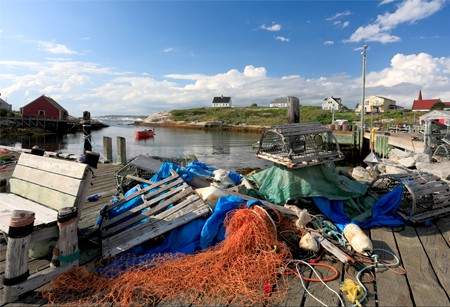
Canada's welfare capital?
Welfare in Canada is often stereotypically associated with the Maritime provinces, where a seasonal fishing industry creates reliable periods of unemployment for lots of workers every year.
Welfare and Pensions in Canada
In response to increasing Canadian life expectancy, the Canadian government has created various pension programs to ensure Canadians will still have access to a livable income even after they are too old to continue working. Today, every Canadian’s paycheque includes a deduction for the Canadian Pension Plan ( CPP ), which is then pooled by the federal government, partially invested in the stock market (via the CPP Investment Board ), and then redistributed in the form of pension cheques to citizens over the age of 65. In addition, there is also the similar but optional Old Age Security Pension ( OAS ) program, which can be opted into by retirement age seniors who have lived in Canada for a significant period of time. Of course, this is just a broad summary. Both programs are, in fact, extremely complicated and bureaucratic, and likely to get even more so as the government is forced to deal with a rapidly aging population. About half of all Canadians are also part of a private pension plan through their employer.
- Public Pensions, Government of Canada
- Reality check: Is CPP going to be around when you retire?, Global News
Welfare is a broad term that basically refers to various forms of financial assistance that are paid by the government to people who, for whatever reason, are not working. Employment Insurance (formerly known by the more dour name Unemployment Insurance) is the most common form of this, and is available to Canadians who have been unexpectedly laid off or forced to quit their jobs for reasons such as pregnancy, illness or injury, or to take care of a sickly loved one. Most provinces offer similar programs known as income assistance for people unable to work, as well as disability assistance programs for people with limiting physical impairments.
- Employment Insurance Benefits, Government of Canada
In general, welfare programs are fairly controversial in Canada and there are social taboos associated with using them for too long. Since the 1990s, welfare rules have gotten steadily stricter, and now it’s usually expected that welfare recipients will be actively seeking jobs or otherwise making plans for their future while on it.
Quick Facts
- Canada is usually considered to be a fairly liberal country in terms of the government's permissiveness towards several controversial social issues.
- Abortion, divorce, gambling, and same-sex marriage are all legal in Canada with few restrictions.
- Purchasing sex, marijuana or hard drugs is not legal, though attitudes may be shifting in a more permissive direction.
- Canada's provinces provide government-run health insurance for all their citizens, which guarantees mostly complete coverage.
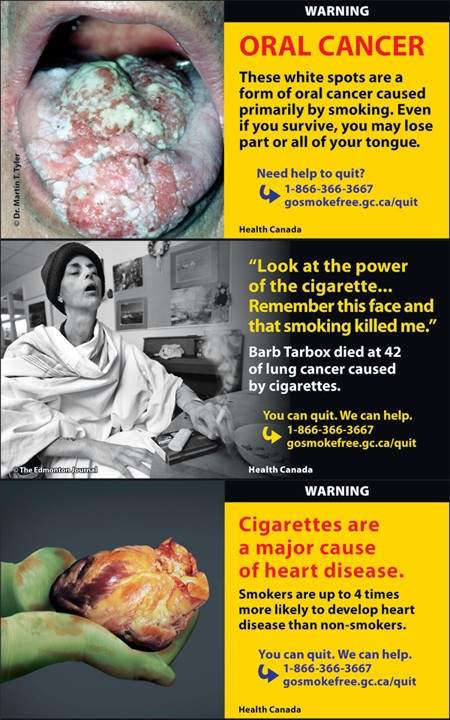
Thank You For Not Smoking
Tobacco cigarettes are legal for Canadians over 18, but in recent years the government has begun to actively discourage their use, both by banning smoking in all public places and forcing cigarette manufactures to place enormous, disgusting warning labels on all cigarette packages.

Safe Injections
Since 2003, the city of Vancouver has provided heroin addicts with free, clean needles and supervised safe injection sites to prevent overdoses and the spread of infectious diseases like HIV and Hepatitis C. Though controversial, the program is now set to come to Toronto, as well.

Cash for Parts?
Federal and provincial laws make it illegal to pay for human body parts in Canada, including organs like kidneys and hearts, as well as bone marrow, eggs, and semen. This means that Canadians who donate body parts for medical procedures are not allowed to receive money for doing do. It's possible to pay blood and plasma donors in some parts of Canada, but this is rare.
Search The Canadian Encyclopedia
Enter your search term
Why sign up?
Signing up enhances your TCE experience with the ability to save items to your personal reading list, and access the interactive map.
- MLA 8TH EDITION
- Sawchuk, Joe. "Social Conditions of Indigenous Peoples in Canada". The Canadian Encyclopedia , 27 May 2020, Historica Canada . www.thecanadianencyclopedia.ca/en/article/native-people-social-conditions. Accessed 21 April 2024.
- The Canadian Encyclopedia , 27 May 2020, Historica Canada . www.thecanadianencyclopedia.ca/en/article/native-people-social-conditions. Accessed 21 April 2024." href="#" class="js-copy-clipboard b b-md b-invert b-modal-copy">Copy
- APA 6TH EDITION
- Sawchuk, J. (2020). Social Conditions of Indigenous Peoples in Canada. In The Canadian Encyclopedia . Retrieved from https://www.thecanadianencyclopedia.ca/en/article/native-people-social-conditions
- The Canadian Encyclopedia . Retrieved from https://www.thecanadianencyclopedia.ca/en/article/native-people-social-conditions" href="#" class="js-copy-clipboard b b-md b-invert b-modal-copy">Copy
- CHICAGO 17TH EDITION
- Sawchuk, Joe. "Social Conditions of Indigenous Peoples in Canada." The Canadian Encyclopedia . Historica Canada. Article published October 31, 2011; Last Edited May 27, 2020.
- The Canadian Encyclopedia . Historica Canada. Article published October 31, 2011; Last Edited May 27, 2020." href="#" class="js-copy-clipboard b b-md b-invert b-modal-copy">Copy
- TURABIAN 8TH EDITION
- The Canadian Encyclopedia , s.v. "Social Conditions of Indigenous Peoples in Canada," by Joe Sawchuk, Accessed April 21, 2024, https://www.thecanadianencyclopedia.ca/en/article/native-people-social-conditions
- The Canadian Encyclopedia , s.v. "Social Conditions of Indigenous Peoples in Canada," by Joe Sawchuk, Accessed April 21, 2024, https://www.thecanadianencyclopedia.ca/en/article/native-people-social-conditions" href="#" class="js-copy-clipboard b b-md b-invert b-modal-copy">Copy
Thank you for your submission
Our team will be reviewing your submission and get back to you with any further questions.
Thanks for contributing to The Canadian Encyclopedia.
Social Conditions of Indigenous Peoples in Canada
Article by Joe Sawchuk
Updated by Anne-marie Pedersen, Velvet Maud, David Koch, Michelle Filice
Published Online October 31, 2011
Last Edited May 27, 2020
Social conditions, including health , income, education , employment and community, contribute to the well-being of all people. Among the Indigenous population in Canada (i.e., First Nations , Métis and Inuit peoples), social conditions have been impacted by the dispossession of cultural traditions, social inequities, prejudice and discrimination . Social conditions also vary greatly according to factors such as place of residence, income level, and family and cultural factors. While progress with respect to social conditions is being achieved, gaps between the social and economic conditions of Indigenous people and non-Indigenous people in Canada persist.
Funding for Social Services
Historically, the federal government has been responsible and provided funding for nearly all the social programs and services provided to Indigenous peoples in Canada. First Nations peoples registered with Indian status receive federal funds for social programs on reserves through the Indian Act . The funding is directed to First Nations band administrations. In the past, discriminatory sections in the Indian Act have prohibited some people, particularly women who married non-status men, from accessing social services. ( See also Women and the Indian Act .) Inuit , Métis and non-status First Nations peoples receive funding through the department of Indigenous Services Canada , created in 2017.
National, provincial and territorial Indigenous representative organizations such as the Assembly of First Nations , Métis National Council , Congress of Aboriginal Peoples and the Inuit Tapiriit Kanatami often have mandates that include the improvement of social conditions and represent or advocate for the interests of their members. Many of these organizations receive funding from the federal government. Friendship Centres (non-governmental agencies) also provide various programs and services to urban Indigenous peoples.
Indigenous Populations in Canada
In 2016, 1,673,785 people reported an Indigenous identity, making up 4.9 per cent of the Canadian population. Additionally, 977,230 people reported being First Nations (including status and non-status people), 587,545 reported being Métis , and 65,025 reported being Inuit . Since 2006, the Indigenous population has grown by 42.5 per cent. This represents a growth rate four times that of the non-Indigenous population.
The Indigenous population of Canada continues to be predominately urban. According to the 2016 census, 867,415 Indigenous people lived in a city of more than 30,000 people, accounting for over half of the total Indigenous population. During this same period, metropolitan areas with the largest Indigenous populations were Winnipeg (92,810), Edmonton (76,205), Vancouver (61,460) and Toronto (46,315).
Income Levels and Education

In 2019, the rate of employment for Indigenous peoples in Canada (57.5 per cent) was lower than the non-Indigenous population (62.1 per cent). The rate for First Nations people (over 15 years old) was 53.8 per cent, 61.3 per cent for the Métis and 49.0 per cent for the Inuit . ( See also Economic Conditions of Indigenous People ).
In comparison to non-Indigenous peoples, Indigenous peoples’ income tends to be below the Canadian average. In 2016, the median after-tax income for non-Indigenous people was $31,144. For those who identified as First Nations, it was $21,253, for Métis, $29,068, and Inuit, $23,635.
In 2016, 68.3 per cent of the Indigenous population aged 25 to 64 had a post-secondary certificate, diploma or degree, compared to 70.4 per cent of the non-Indigenous population. Contemporary research has found that educational attainment rates and income are directly related. Indigenous educational programs are crucial to closing the income gap between Indigenous and non-Indigenous wage earners. ( See also Education of Indigenous Peoples in Canada .)
Housing and Living Conditions
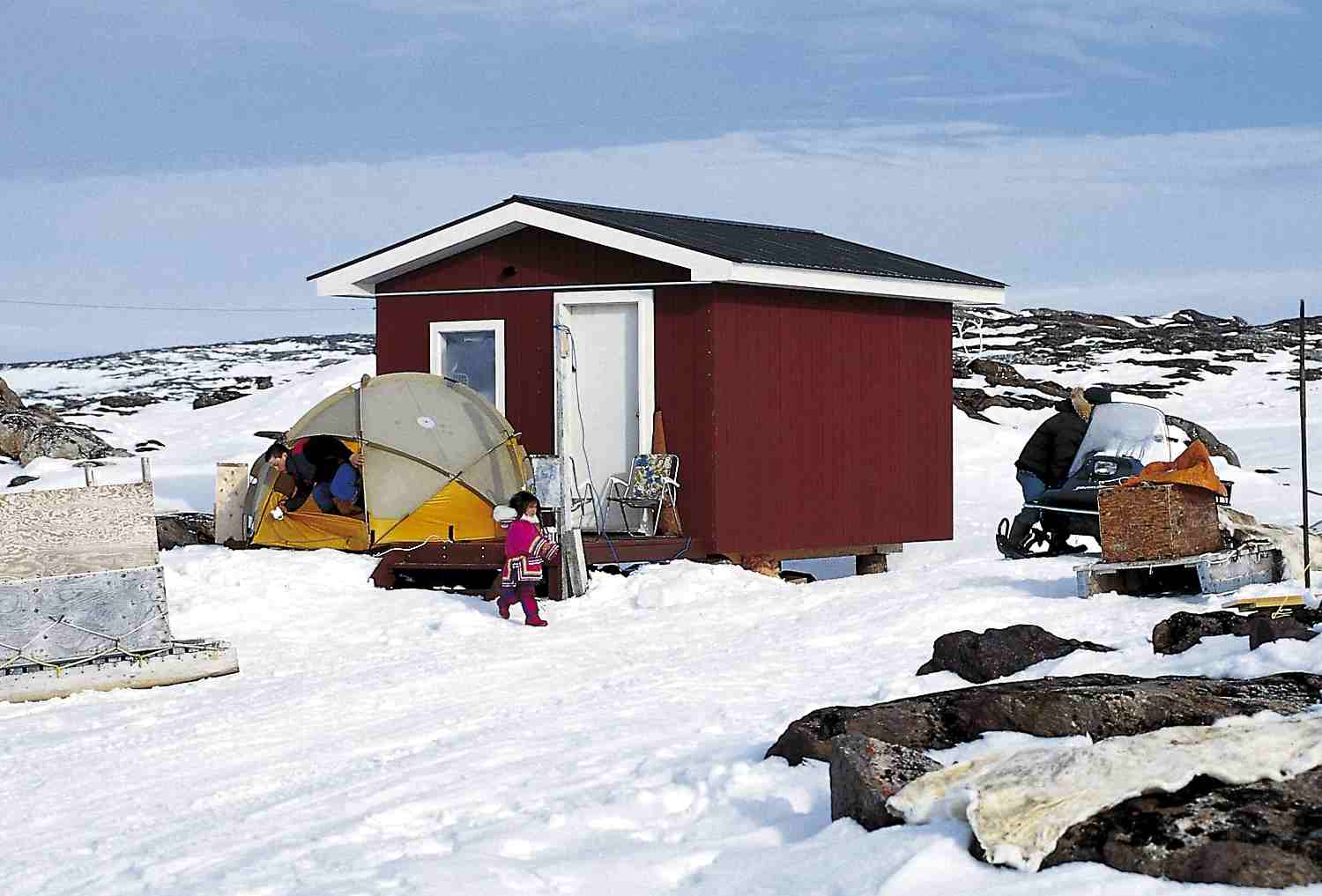
In 2016, one in five Indigenous people (19.4 per cent) lived in a dwelling that required major repairs, compared to 6 per cent of the non-Indigenous population. Mould , bug infestations, inadequate heating and contaminated water ( see also Grassy Narrows ) are just some of the issues that plague First Nations peoples living on reserves .
Overcrowding is another issue affecting Indigenous living conditions. In 2016, 18.3 per cent of Indigenous people lived in overcrowded housing, compared to 8.5 per cent of the non-Indigenous population. In the same year, 40.6 per cent of Inuit and 8.6 per cent of Métis lived in housing that was crowded. The number of First Nations people living in a crowded dwelling on reserve (36.8 per cent) was higher than First Nations people living elsewhere in Canada (18.5 per cent).
Health of Indigenous Peoples
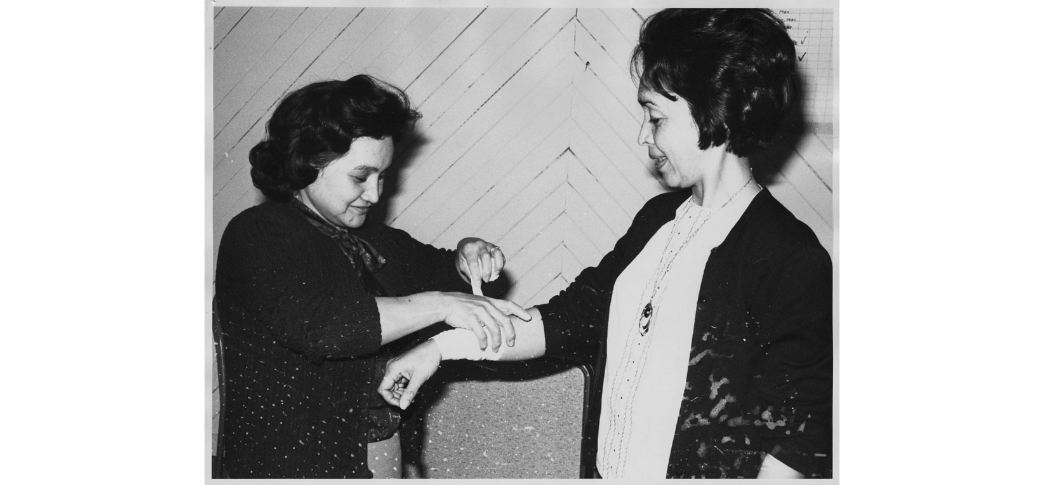
Indigenous households are more likely than non-Indigenous households to experience food insecurity. In 2019, 48 per cent of First Nations households did not have enough income to cover their food expenses. In comparison, the food insecurity rate for the country was 8.4 per cent.
People living in remote and northern communities have a more difficult time accessing and affording food. In Nunavut , for example, 46 per cent of households were affected by food insecurity in 2016. Access to certain foods such as fruit, vegetables and milk is more difficult because they must be transported long distances. The resulting high costs, limited availability and lower quality of the food contributes to food insecurity.
In some communities, the harvesting of traditional foods, such as seal , caribou , duck , whale and fish , helps to offset some of the issues accessing food. However, many communities continue to call on governments for increased support. ( See also Country Food (Inuit Food) in Canada .)
Criminal Justice System
Indigenous people are over-represented in the criminal justice system as offenders and inmates, and under-represented as officials, officers, court workers or lawyers. Rates of incarceration among the Indigenous population continue to increase. In 2016-17, Indigenous adults accounted for 27 per cent of admissions to federal correctional services, compared to 23.2 per cent in 2013. Over-represented in federal corrections facilities, Indigenous peoples make up 20 per cent of the total imprisoned population even though they only comprise 4.9 per cent of the Canadian population. Indigenous youth are also overrepresented in the correctional system. They account for 46 per cent of admissions in 2016-17, while representing 8 per cent of the Canadian youth population.
Several social factors have contributed to the over-representation of Indigenous people in the justice system. A history comprised of dislocation from traditional communities, disadvantage, discrimination, forced assimilation including the effects of the residential school system, poverty, issues of substance abuse and victimization, and loss of cultural and spiritual identity are all contributing factors. ( See also PTSD: Intergenerational Transmission of Trauma .)
In a landmark Supreme Court of Canada decision, the Gladue case in 1999 advised that lower courts should consider an Indigenous offender’s background and make sentencing decisions accordingly, based on section 718.2 (e) of the Criminal Code . To date, many Indigenous-directed alternatives to incarceration in correctional facilities are being developed, including healing and sentencing circles. However, there are still many questions surrounding the unfair and inhumane treatment of Indigenous peoples in modern jails.
Because existing police forces are not always aware of the cultural differences and needs of Indigenous communities, Indigenous people began to develop their own police forces in the 1970s and 1980s. Indigenous police recruitment programs helped the RCMP and other police forces to add Indigenous constables to their staffs. In 1991, the federal government introduced the First Nations Policing Policy to meet the needs of Indigenous communities. While 62 per cent of officers in First Nations police services identified as Indigenous in 2018, Indigenous officers still only represent 4 per cent of police officers in Canada.
Indigenous Children and Families
In 2016, 60.1 per cent of Indigenous children under the age of four lived in a two-parent household and 34 per cent lived in a one-parent household. Comparatively, 86.2 per cent of non-Indigenous children lived in a two-parent household and 13 per cent lived with one parent.
Indigenous children are more likely to live in homes with grandparents. Among the Indigenous population in 2016, 21 per cent of First Nations , 11 per cent of Métis and 23 per cent of Inuit children under the age of four lived with at least one grandparent. Among the non-Indigenous population, 10 per cent of children aged four and under lived with at least one grandparent.
Since the 1960s, a large number of Indigenous children have been placed in care by social agencies. ( See also Sixties Scoop .) In 2016, Indigenous children made up nearly half of all children in foster care in Canada, even though they only made up 7 per cent of children in the country.
Improving Social Conditions
Progress with respect to social conditions is being achieved. However, the gaps that persist between the social and economic conditions of Indigenous people in Canada and those of the general Canadian population continue to pose challenges. Areas of particular social concern include housing , employment, education , health , justice and family and cultural growth. Many communities are implementing community-based strategies stressing the importance of history and culture; governance, culture and spirituality ; unique qualities and values; the link between self-government and economic development; and the role and importance of traditional economies.
Inuit Collection

Indigenous Peoples Collection

Métis Collection

- socioeconomic issues
- Indigenous Peoples
- social conditions
Further Reading
Heather A. Howard and Craig Proulx, Aboriginal Peoples in Canadian Cities: Transformations and Continuities (2011).
David Long and Olive Dickason, Visions of the Heart: Canadian Aboriginal Issues , 3rd ed. (originally published in 1996; 2016).
Marie Battiste, Reclaiming Indigenous Voice and Vision (2011).
Margo Greenwood, Sarah De Leeuw, Nicole Marie Lindsay and Charlotte Reading, eds., Determinants of Indigenous Peoples’ Health in Canada (2015).
External Links
Health Canada First Nations and Inuit Health
CBC News Missing and Murdered: The Unsolved Cases of Indigenous Women and Girls
Government of Canada Budget 2016 Highlights – Indigenous and Northern Investments
Children and Youth: Crime Prevention Through Social Development “Social Challenges: The Well-being of Aboriginal People”
Truth and Reconciliation Commission Learn more about TRC and the ongoing impacts of residential schools on Indigenous cultures and societies
Toronto Star “Attawapiskat Shacks Put First Nations Housing Crisis into Perspective,” by Colin Perkel
Recommended
Education of indigenous peoples in canada, residential schools in canada, indigenous women and the franchise.
We use cookies to enhance our website for you. Proceed if you agree to this policy or learn more about it.
- Essay Database >
- Essay Examples >
- Essays Topics >
- Essay on Culture

Free Social Issues In Canadian Society Essay Example
Type of paper: Essay
Topic: Culture , Taxes , Poverty , Violence , Homelessness , Society , Canada , Tourism
Published: 03/11/2020
ORDER PAPER LIKE THIS
Canada is in the top five countries in the world to live in. Its laws and policies are trying hard to make sure that all citizens are provided with equal rights and opportunities. However, what most people do not know is that it is a huge country with still huge social issues. The major issues that are still looming in the Canadian society are Homelessness, Immigrant issues and Violence. Furthermore, there is a big problem faced by new immigrants to Canada. Most people are already financially challenged and on top of that, there is a huge cultural difference. They have to get used to the difference in languages and try to blend into the crowd. Finally, many people face discrimination in Canada due to their cultural background and language. (Travel.gc.ca) Moreover, Canadian society has recently seen an increase in violence. Many analysts link this violence homelessness and poverty. However, low income is not the only cause of violence. Living in shelters and foster care are also a huge factor of increasing violence. This is because parental values are at a minimum in such environments. To conclude, community environment, parental values and low income are the root causes of the increase in violence in Canada. (children.gov)
"Coping with culture shock - Travel.gc.ca." Travel.gc.ca. N.p., 30 Sept. 2014. Web. 28 Oct. 2014. <http://travel.gc.ca/travelling/living-abroad/culture-shock>. Gaetz, Stephen, Jesse Donaldson, Tanya Gulliver, and Tim Richter. "The State of Homelessness in Canada 2013." A HOMELESS HUB RESEARCH PAPER. N.p., n.d. Web. 29 Oct. 2014. <http://www.wellesleyinstitute.com/wp-content/uploads/2013/06/SOHC2103.pdf>. "Review of the Roots of Youth Violence: Executive Summary." What are the Roots?. N.p., n.d. Web. 28 Oct. 2014. <http://www.children.gov.on.ca/htdocs/English/topics/youthandthelaw/roots/what.aspx>

Cite this page
Share with friends using:
Removal Request

Finished papers: 2796
This paper is created by writer with
ID 255209254
If you want your paper to be:
Well-researched, fact-checked, and accurate
Original, fresh, based on current data
Eloquently written and immaculately formatted
275 words = 1 page double-spaced

Get your papers done by pros!
Other Pages
Early childhood research papers, operation thesis proposals, style thesis proposals, print thesis proposals, hundred thesis proposals, commitment thesis proposals, universe thesis proposals, venture thesis proposals, spread thesis proposals, gas thesis proposals, path thesis proposals, questionnaire thesis proposals, research paper on cholesterol testing, example of research proposal on nursing finance, sociology structural functionalism conflict theory and symbolic interactionism critical thinkings example, free the size of fast food industry in beijing and new york essay sample, sample report on my personality theory paper the 5 dimensions of personality, example of essay on the new world, sample essay on behavior as a function of the person environment interaction, good rhetorical analysis of two news articles essay example, precept essays, sevastopol essays, moray essays, sammy essays, lengel essays, three girls essays, carnality essays, embarrass essays, misogynist essays, pencil case essays, westside essays, wabash essays, godot essays, legal personality essays, clapham essays, screams essays, ardenne essays, morte essays, st thomas essays, st thomas aquinas essays, trouville essays, onlooker essays, reddish orange essays.
Password recovery email has been sent to [email protected]
Use your new password to log in
You are not register!
By clicking Register, you agree to our Terms of Service and that you have read our Privacy Policy .
Now you can download documents directly to your device!
Check your email! An email with your password has already been sent to you! Now you can download documents directly to your device.
or Use the QR code to Save this Paper to Your Phone
The sample is NOT original!
Short on a deadline?
Don't waste time. Get help with 11% off using code - GETWOWED
No, thanks! I'm fine with missing my deadline
- Tools and Resources
- Customer Services
- Addictions and Substance Use
- Administration and Management
- Aging and Older Adults
- Biographies
- Children and Adolescents
- Clinical and Direct Practice
- Couples and Families
- Criminal Justice
- Disabilities
- Ethics and Values
- Gender and Sexuality
- Health Care and Illness
- Human Behavior
- International and Global Issues
- Macro Practice
- Mental and Behavioral Health
- Policy and Advocacy
- Populations and Practice Settings
- Race, Ethnicity, and Culture
- Religion and Spirituality
- Research and Evidence-Based Practice
- Social Justice and Human Rights
- Social Work Profession
- Share This Facebook LinkedIn Twitter
Article contents
Social policy in canada.
- Micheal L. Shier Micheal L. Shier University of Pennsylvania
- and John R. Graham John R. Graham Florida Atlantic University
- https://doi.org/10.1093/acrefore/9780199975839.013.947
- Published online: 02 June 2014
The focus and aim of social policy in Canada have in part been determined by the unique sociohistorical and cultural context of the country. This entry provides a brief overview of the leading factors that have contributed to the development of social policy in Canada. Emphasis is placed on the economic, social, and cultural context of the development of the country, along with the system of governance and the ideological framework among the general populace. Following this contextualization, four dominant periods of social policy are described. These include the residual period, the emerging institutional period, the institutional period, and the postinstitutional period. In each era the forces leading to specific social policy outcomes are described. These include aspects of the changing economic system and emerging cultural and social needs among the population. Key social policies in each era are introduced and described. Fundamental to each period of social policy development are the efforts of the voluntary sector. In conclusion, future trends in social policy and social welfare in Canada are discussed.
- social policy
- social welfare
- welfare state
Introduction
Social policy is an aspect of the public policy framework within a given country’s context. Public policy covers a range of social, legal, political, economic, and cultural policies that affect the way people experience their social environment and also provides a framework of governance for a particular nation-state. Social policy is defined here as those public policies that address the social (including the sociopolitical, sociocultural, and socioeconomic) conditions of a country’s citizenry. In Canada, the primary focus of legislation aimed at addressing the social condition of Canadians has tended to focus on issues of minority status, income inequality, labor market attachment, housing, child care and support, immigration, and health care. Throughout Canadian history, the social policy framework has been composed of efforts to address the sociopolitical rights of marginalized segments of the population (such as laborers, Aboriginal people and other visible minority populations, women, disabled people, and sexual minorities), along with addressing the negative conditions in which people live through the creation of national and provincial programs of social support (such as community programs of support directed toward new immigrants or disabled people) and economic support (such as unemployment insurance or family allowance payments).
The following provides a historical overview of the development of Canadian social policy through four eras of social welfare development. These include the residual period, the emerging institutional period, the institutional period, and the present postinstitutional period. In each era, key social policies are described. Prior to this discussion, the first section outlines the Canadian context. A brief description is provided of the key cultural, social, and economic factors for which social policies have emerged in Canada, the system of governance in Canada, and a discussion of the ideological framework that social policy stems from in Canada. The social policy framework in Canada is largely a condition of this unique context.
Cultural, Social, and Economic Context
There are several unique cultural and social factors within Canadian society that contribute to the focus of social policy. For instance, from a sociohistorical standpoint, the geopolitical territory of the Canadian nation-state was initially only inhabited by Aboriginal (or First Nations) people, but was subject to European colonization, with both British and French settlers migrating to Canada. This sociohistorical context essentially created two long-lasting cultural divisions within Canada that have required substantial public policy intervention to deal with social issues of equality and social exclusion, that between Aboriginal people and migrants and between French-and English-language speakers.
Early public policies directed toward Aboriginal populations favored assimilation and loss of First Nations cultural identity. In 1876 the federal government passed the Indian Act, which labeled Aboriginal people wards of the federal government, giving them a distinct legal status. However, to gain citizenship rights in Canada, Aboriginal people had to apply for enfranchisement, and a requirement to attain citizenship status was that they had to undergo complete assimilation with the European Canadian culture (Graham, Swift, & Delaney, 2012 ). This assimilation was attained through the institutionalization of residential schools. During the late 1800s residential schools became commonplace, and in many parts of the country these were the only schools made available to Aboriginal people (Finkel, 2006 ). Attendance at these schools resulted in the separation of Aboriginal children from their families and was a concerted effort by the federal government and local religious organizations to force assimilation with the European Canadian culture of the country.
In the earlier days of confederation the European Canadian culture was also divided based on differing European cultural backgrounds and languages. Prior to British colonization, parts of Canada were settled by French migrants along the St. Lawrence River (referred to as the Canada colony and later named the Province of Quebec), extending northward to the Hudson Bay and on the south shore of Newfoundland and throughout the four Atlantic provinces (referred to as Acadia). This territory was a part of what was known as New France, the North American settlement of the French Empire. The parts of New France that would later make up the eastern part of the nation-state of Canada were ceded to the British Empire in the Treaty of Paris in 1763. Although authority of the New France colonies changed hands, this mixed European settlement created two distinct European cultural identities—primarily fixated around language—that would have long-lasting implications on the social and cultural context of the country. As a result, this would have a significant impact on the focus and direction of social policy.
Similarly, Canada’s colonial history has resulted in the need to address several other emergent issues related to diversity and equality. To adapt to the increasingly globalized and industrialized international political economy, Canada’s population had to grow. As a colonial country, international migrants were necessary. Although initial waves of migrants tended to include French, British, and American settlers, prior to World War I and following World War II large numbers of settlers were migrating to Canada from continental Europe, including Ukrainian, Dutch, Scandinavian, German, and Russian migrants. Beginning in the 1970s, the majority of new migrants to Canada were (and continue) to be from developing nations, such as China and India. These migration patterns have created a distinctly multicultural society within Canada with a highly diverse population based on religious affiliation, language, and ethnoracial identity. A result has been the need to develop a national social policy on Canada’s unique multicultural context along with social policies preventing discrimination.
Beyond ethnoracial minority status, Aboriginal status, and language rights, the women’s rights and labor movements have been two other dominant factors shaping the direction of social policy and social welfare in Canada. These two movements were instrumental in the development of a vibrant civil society culture within Canada and the establishment of a tradition of general civic protest in situations of apparent inequality. The labor rights movement began in the mid to late 1800s. The first large act of labor unrest was the Nine-Hour Movement in 1872, in which workers in Ontario and Quebec held rallies and protests in defiance of the existing legislation that banned the formation of labor unions. Later that year, the Trade Unions Act was passed, which established labor unions as legal entities. Following the passing of this seminal labor legislation, labor protests and rallies continued to establish union recognition in many employment sectors over the next several decades. This subsequently led to the death of many striking workers. In 1944 the federal government enacted the Privy Council Act 1003. This order further solidified into law the role of labor unions in negotiating the rights of workers and ordered businesses to recognize the chosen labor union of the workers (Graham et al., 2012 ).
The women’s movement in Canada also began in the late 1800s. This early movement aimed to attain gender equality through the establishment of equal citizenship rights between men and women. It would take several decades for women to gain the voting rights of citizenship. Like the labor rights movement, the women’s movement in Canada was instrumental in establishing the relationship between civil society actors and the varying levels of government. Prior to 1920, women were not permitted to vote in Canada. In 1900, the Dominion Elections Act was passed, which legally prohibited women, Aboriginal people, and ethnic minorities from voting in federal elections. In 1920, the act was amended, which granted voting rights to women in federal elections. Around the same time, women were granted the right to vote in 7 of the 9 provinces at that time (the 10th Canadian province, Newfoundland, did not join the confederation until 1949). However, it was not until 1929 when a legal challenge led by five Canadian women resulted in women being legally considered “persons” in Canada’s constitution. These earlier social movements in Canadian history established a civil society culture among the populace and created an institutional environment in which engaged citizens challenged social inequality and exclusion by seeking to gain federal and provincial social policy reform. Following these movements, several others emerged. These include nationally focused movements to address the social and economic inequality experienced by disabled people, the elderly, and sexual minorities.
Finally, the economic conditions of the country have also been instrumental in defining the trajectory of Canadian social policy and social welfare development. Canada, like other industrialized, developed nations, follows a capitalistic economic system. And, like other industrialized, developed nations, throughout Canada’s economic history the country has been impacted greatly by economic recessions and depressions that have historically hit the developed parts of the world. Recessions and depressions are commonplace; however, they can have immediate and longer term implications for economically vulnerable citizens. Because Canada follows a market-based system of exchange, to provide some element of protection against the unfettered free market, the Canadian government (as elsewhere throughout the developed world) had to enact efforts of redistribution to address these vulnerabilities. Of late, the capitalistic system of economic exchange would have significant implications for the future trajectory of social policy in Canada. With the emergence of supply-side economics in the 1980s throughout many industrialized, developed nations, efforts of income redistribution have waned, with an increasing reliance on the efforts of community-based organizations and other civil society actors such as volunteers and donors.
Canada is a federal parliamentary democracy. The governing system in the country is made up of a federal governing body in which the leader of the government is also a member of the legislature. The parliament is composed of two chambers. The first is the legislature (or the House of Commons) and the second is the Senate. Once legislation has been passed by the elected officials in the legislature, the senate then reviews the legislation before it is passed into law. However, because the senate is not an elected body it does not have any functional authority in developing new programs and policies. It is widely recognized in popular Canadian culture that the senate provides “sober second thought.” As a result of this system of governance, at the federal level of government the focus of social policy is dominated by a system of “party politics” in which elected parties—if they are fortunate to receive a majority government in the House of Commons—set the social and economic agenda of the country.
Beyond the federal government, Canada is also composed of 10 provinces and 3 territories, each with its own governing bodies. Of importance to note is that the provincial governments have constitutional jurisdiction in the provision of health and social services (including education) to its residents. From its inception in 1867, the British North America Act clearly delineated roles regarding matters of health, social services, and education to the provincial levels of government. As a result, as Boychuk ( 1998 ) argues, Canada looks “more like a patchwork of ten distinct provincial variants than a national system” (p. 41) of social welfare. There are different approaches to social welfare in Canada depending on the unique social, cultural, and economic traditions within a particular province.
However, following World War II the federal government was able to create some level of consistency across the country through regulations attached to federal government funding to the provincial levels of government. For instance, in 1966 the federal government created the Canada Assistance Plan. The plan acted as a cost-sharing program between the federal and provincial levels of government for health-related and social services–related programming. With the Canada Assistance Plan came increased restrictions placed on provincial governments on how the funding could be spent. However, in efforts to decentralize the federal government’s role in defining social welfare programs, the Canada Assistance Plan was replaced with the Canada Health and Social Transfer in 1996 and later divided into two separate transfers in 2004: the Canada Health Transfer and the Canada Social Transfer. With these changes to the transfer programs, which fund provincial health, education, and social services programs, the federal government reduced the amount of funding provided to the provinces as well as their ability to regulate the use of these funds (Graham et al., 2012 ).
Beyond the federal and provincial levels of government are the municipal governments. Local municipal governments are established to govern cities, counties, and other municipal jurisdictions. Although municipal governments have made attempts historically to gain more authority, provincial governments in Canada have maintained their authorities in the provision of health, social service, and education programs. However, municipal governments are instrumental in the delivery of services in many jurisdictions in Canada. For instance, depending on the jurisdiction in Canada, the municipal governments can be responsible for the provision of child welfare services, housing and homelessness-related services, and rehabilitation services, among others (Graham et al., 2012 ). As a result of recent funding cutbacks to the health and social services transfer payments from the federal government to the provinces, municipal governments have been faced with large cutbacks to the social and health service programs they cost share with their provincial governments, which makes it increasingly difficult for them to address emerging needs within their local communities. And because there are provincial restrictions on the collection and use of tax revenue by municipalities, city governments are prevented from generating the resources needed to address the shortcomings in these transfer payments from higher levels of government for local social service programs.
A Liberalist Ideology
In democratic nations, central features of public policies are the values, beliefs, and ideological perspectives of a group of citizens. In many cases, these individuals make up the majority in the general populace. With regard to these particular values and beliefs, Canadian social policy has been generally characterized as being a remnant of a liberalist worldview and public policy framework (Esping-Andersen, 1990 ). What this means is that Canadian society (or its governance), much like the United States and United Kingdom, inherently values a free-market capitalist economy. At the same time, Canada has had a different political tradition than the United States, particularly with regard to a positive role for the state in the provision of peace, order, and good government, and in an ideology that has been more accepting of social interventions such as the welfare state (Lipset, 1989 , in Graham et al., 2012 ). Canada has also had a Red Tory tradition within Canadian conservative political parties as well as a social democratic tradition—the latter including the 1932 creation of the Cooperative Common Wealth Federation (in 1961 it became the New Democratic Party) and the election of the continent’s first major social democratic government in Saskatchewan in 1944 (Graham et al., 2012 ).
A classic differentiation between liberal and other welfare state systems is the extent to which individuals within a country are able to attain a standard of living that is completely independent of market forces (Esping-Andersen, 1990 ). The central question then becomes to what extent, through the efforts of governments to implement social policy, are individuals perceived as commodities by the labor and economic markets? And does the aid and assistance provided to individuals in a specific country context create a sufficient standard of living for individuals who do not participate in the market? Because Canada follows from a liberalist ideological tradition—which is evidenced by its system of governance and its methods of economic exchange—its responses, through the development of social policy, to address the social conditions of its citizens have been restricted to remedial measures of redistribution through the provision of income-security programs and direct support programs that aim to enable individuals to participate fully in Canada’s labor market.
Four Periods of Welfare State Transitions
The previous description of the Canadian context is an important foundation for understanding historical and present social policy in Canada. This unique social and cultural context provides a lens for understanding why certain areas of social policy developed at key historical times in Canada’s development. Furthermore, the economic and ideological context provides a rationale for why certain social policy approaches have been favored over others. Finally, the Canadian system of government places limitations on how different levels of government can act in efforts to address the experiences of the country’s most vulnerable citizens. However, it is not only the government that has been instrumental in defining the direction of social welfare and social policy in the country. Community-based (or civil society) actors have been instrumental in formulating the social welfare and social policy agenda. The following provides a historical overview of four periods of welfare state development in Canada. Instrumental through these periods is the role of grassroots advocacy–based efforts to address issues of social inequality and exclusion in Canadian society.
Residual Period
The residual period of Canadian social policy and welfare begins prior to European contact to the period from New France until shortly after confederation in 1867. Prior to European colonization of what is known today as Canada, Aboriginal people engaged in practices of reciprocity to meet the needs of the aging, the sick, and the vulnerable. Tribal, clan-based, and family-kinship relationships were the dominant forms of social organization and were relied upon to meet the social welfare needs of individuals. As Finkel ( 2006 ) points out in the pre-European contact years, civilization in North America managed to maintain principles of egalitarianism through trade relations between tribes and clans as well as indiscriminant practices of medical attention for the sick and injured, and the elderly and vulnerable were taken care of to the best of the Aboriginal groups’ ability. However, following French settlement, practices of social organization from French society and other European cultural groups were introduced to the new colonial territories that would have a lasting impact on methods of social welfare intervention.
During the residual era of social welfare in Canada, emphasis was placed on the role of immediate family members in taking care of the needs of individuals whose labor market attachment was interrupted. This included the needs of the unemployed, the elderly, and the sick. Only after these resources were exhausted would individuals (or their families) turn to extended family members, local community members, or religious organizations for assistance (Graham et al., 2012 ). The Elizabethan Poor Law traditions of England were particularly influential in the development of Canadian social welfare policy beginning with the cessation of New France to the British in the mid-1700s. Prior to the English poor laws in England, three dominant institutional forms of social welfare provision emerged. These included the merchant guilds, private foundations, and the Roman Catholic Church. The merchant guilds were composed of merchant and artisan classes and created mutual aid societies to meet the needs of its members. Private foundations were developed by wealthy benefactors and were predominantly focused on building hospitals and almshouses. Finally, the Church provided assistance to individuals in local communities through various monastic orders (Graham et al., 2012 ). However, in 1601, when the Elizabethan Poor Laws were passed, authority was given to the local parish governments throughout England to address the plight of the poor and to provide punishment to those individuals who refused to participate in general labor. This earlier transition from local community responses to address issues of poverty and vulnerability to a nationally focused system of social welfare with local control is the foundation for social welfare in Canada (Graham et al., 2012 ).
One other aspect of the Elizabethan Poor Laws that had a significant impact on the development of social welfare in Canada during the residual period and beyond was the delineation between the deserving and undeserving poor. Individuals requiring social support were labeled as impotent, able-bodied, or unregenerate idlers. The first were assigned to the almshouses, the second to the workhouses, and the latter to prisons (Graham et al., 2012 ). During more contemporary times, income-security programs in Canada have relied on distinguishing among individuals’ capabilities to work. These distinctions have defined the eligibility criteria for provincially based social assistance programs, employment insurance, and disability benefits. In England, these eligibility criteria became more clearly defined and resulted in the Poor Law Reform of 1834. With this reform, more stringent eligibility criteria were introduced to reduce the rising number of individuals receiving relief. Along with the eligibility reform there was a distinction made between individuals who received “indoor” or “outdoor” relief. Indoor relief referred to those able-bodied men who were considered employable. Individuals receiving indoor relief were required to work in workhouses to receive support. However, individuals receiving outdoor relief were the elderly, the sick, or the orphaned, all of whom were generally perceived as unable to work (Graham et al., 2012 ). Remnants of this divisive system of social welfare are apparent throughout the history of Canadian social policy and social welfare. For instance, income-security programs have been tied to eligibility criteria, and the types of income support received are based on an individual’s ability to participate fully in the labor market.
The system of social welfare outlined by the Elizabethan Poor Laws was applied haphazardly throughout Canada prior to confederation in 1867. Because of the large geographic terrain, the low population density in many areas of the country, and the unique cultural traditions of the increasingly diverse population base, it was difficult to institute a nationally orientated program of social welfare. Instead, during this residual period of social welfare there were distinctive practices in each of the provinces/territories of that time. For instance, Nova Scotia and New Brunswick utilized the Elizabethan Poor Law framework with local overseers of the poor. However, Quebec relied heavily on the Roman Catholic Church to oversee the needs of the poor in local communities. And in Ontario, local community-based efforts by concerned citizens and municipal governments were the dominant actors engaged in addressing the social conditions of vulnerable citizens (Boychuk, 1998 ; Graham, 1995 ; Graham et al., 2012 ; Splane, 1965 ). Even with these distinctions, what is apparent from this residual period of social welfare provision in Canada are the direct influences from the emerging European system of social welfare. The tenants of the Elizabethan Poor Laws would have a long-lasting impact on the development of social welfare in Canada, with particular emphasis placed on labor market attachment and a distinct division of what would be understood as the deserving and undeserving poor in Canadian popular culture.
Emerging Institutional Period
The emerging institutional period of social policy and social welfare in Canada began postconfederation (around 1867) to World War II (around 1943). In 1867 the colonies of British North America converged to form Canada. In the years leading up to confederation, Canada began to develop into an industrialized nation, transforming from a small, resource-based economy. With increased industrialization came increased urbanization and population growth. As a result, increased pressures were placed on the government to adapt its provisions of social welfare. Of particular importance during this era was the institutionalization of a vibrant voluntary sector. Charity-based organizations began to proliferate. These included city missions, orphanages, refuges for the elderly, and philanthropic foundations. For instance, the Young Men’s Christian Association was established in Montreal in 1851 and provided support in response to the negative social conditions that were a direct result of industrialization. The Young Women’s Christian Association was established in 1873 in New Brunswick. The Haven, a local Toronto-based charity, was established in 1878 and provided services to individuals experiencing mental illness. The first Boys Club was established in New Brunswick in 1900 and aimed to provide recreational activities to young boys. The present John Howard Society of Canada began in 1867 as a small group of reformers who sought to provide spiritual guidance to incarcerated people. In 1874, the group became known as the Prisoners Aid Association of Toronto. The Salvation Army began to undertake its work in 1882 in Canada by providing meals to hungry people. Other organizations during this time included the Toronto Children’s Aid Society in 1891, the Red Cross in 1896, the Victorian Order of Nurses in 1897, the Toronto Family Service Agency in 1914, the Canadian Mental Health Association in 1918, the Canadian Institute for the Blind in 1918, the Canadian Council of Social Development in 1920, and the Canadian Association of Social Workers in 1926.
There were many more organizations than are listed here. During this era, social welfare became more institutionalized within Canada. Individuals and organizations were actively pursuing the betterment of the social conditions in which people lived. Of importance were issues related to poverty, working conditions, and religious and moral order. The development of these organizations was simultaneously happening with larger social movements among concerned citizens. Previously mentioned was the labor movement, which sought to address the negative working conditions and insufficient rates of pay for Canadian workers. At the same time, other groups were concerned with living conditions in Canada’s cities along with the persistent challenges of poverty. For instance, the settlement house movement—which was unique to North America—began in the late 1800s and continued through to the early 1920s. The focus of the settlement movement was on community development and providing programs to recent immigrants. Similarly, the Social Reform Movement began in the mid-1800s and sought to address issues of urban poverty. The work of many locally based social service organizations such as the Young Men’s Christian Association, local relief missions, and the Salvation Army was part of this larger movement in Canadian society.
Characteristics of this emerging institutional period had long-lasting implications for the future development of social welfare and social policy in Canada. This tradition of local community-based activism and organizations was instrumental in the independent-living movement (or the deinstitutionalization of psychiatric facilities) in the 1970s. Also in the 1970s, institutional frameworks of social welfare provision were developed for women experiencing domestic violence and individuals needing addictions treatment and intervention (also known as the Recovery House Movement), all of which were initially the result of active citizen engagement to address emerging (or long-lasting) challenges in the social strata of Canadian society. Similar movements were seen also in the 1980s by HIV/AIDS activist organizations seeking adequate government support for individuals affected by HIV/AIDS.
During the emerging institutional period of social welfare, through the efforts of community-based organizations and citizen engagement, the plight of those living in negative social conditions was brought to the forefront (see, for example, Emery & Emery, 1999 ; Graham, 1992 , 1996 ). However, until the 1930s the local municipalities were primarily responsible for providing for the social welfare needs of the residents. The staggeringly high level of unemployment that resulted from the Great Depression made it impossible for local community governments to provide sufficient relief to residents, and as a result, the provincial governments had to take on more responsibility.
Furthermore, another significant advancement during this era was the emergence of the profession of social work. As a result, a professional ethos began to be applied to the social conditions of industrialization. In 1914, the first School of Social Work was established at the University of Toronto, followed by programs at McGill University in 1918 and the University of British Columbia in 1928.
Key social policies that emerged during this era were workers’ compensation benefits, which were passed in Ontario in 1914 and subsequently adopted by the other provinces. Workers’ compensation provided benefits to workers who were temporarily unable to work because of injury. Also, following World War I, veterans who were returning from war were provided with retirement annuity insurance assistance in 1920; later, in 1927, they were granted settlement assistance, and then in 1930 allowances were granted to the widows and orphans of veterans who did not have sufficient financial means to take care of themselves. In 1916 the province of Manitoba created a Mothers’ Allowance program to support single mothers who were widowed, divorced, or deserted. This program was similarly followed in other provinces shortly thereafter. Following this, in 1927 the federal government created a cost-sharing program with the provinces through the Old Age Pensions Act. The program was also selective. And in 1940 Unemployment Insurance was introduced after a several-year delay, caused by the reluctance of the federal government to amend the Canadian constitution giving them jurisdiction in this area of social welfare (Graham et al., 2012 ).
Institutional Period (Traditional Welfare State Era)
The institutional period of Canadian social policy and social welfare begins during World War II through the mid-1970s. A general time frame is 1943 through 1975. This particular era has also been described as the traditional welfare state era. Characteristic of this particular era is the presence of a centralizing tendency within Canadian social policy and programming in efforts to address the social welfare needs of the country’s citizenry on a wider scale. This period reinforced societal constructions of race, sexual orientation, and gender and has been critiqued for its patriarchal emphasis on income-security programs attached to an ethos of the breadwinner male (Ursel, 1992 ).
In 1943, the Report on Social Security for Canada (also known as the Marsh Report because it was written by the economist Leonard Marsh) was released. The report, much like the Beveridge Report in Britain, acted as a blueprint for the establishment of a universal system of social welfare in Canada. Contrary to previous eras of social welfare development, characteristic of the Marsh Report was its positive perspective on the role of modern industrialized societies in addressing the social welfare needs of its citizenry (Graham et al., 2012 ). During this era, a sense of entitlement to welfare state benefits prevailed over the stigmatizing notions of means-tested programs that were commonplace previously (Graham, 2008 ).
Following the introduction of Unemployment Insurance in 1940, in 1944 the Family Allowance program was established. This universal program provided income supplements to all mothers in the country who had children under the age of 16 years. In 1951, the previously established pension program under the Old Age Pensions Act (1927) became a universal program known as Old Age Security. As of 1951, all seniors over the age of 70 would receive a pension no matter what their level of income (Graham et al., 2012 ). In 1945 the province of Saskatchewan (under the leadership of the premier Tommy Douglas) introduced a social assistance medical care plan for old-age or blind pensioners, recipients of the Mothers’ Allowance, and wards of the state. This selective program was amended in 1947 with the creation of a universal, provincially administered hospital insurance program and was later replaced by universal, province-wide medical insurance in 1959. Health care was also being considered at the federal government level. In 1956 the Hospital Insurance and Diagnostic Act was passed, a cost-sharing initiative between the federal government and the provinces in the provision of basic in-patient hospital services. Then, following the lead of the province of Saskatchewan, the federal government created a national system of health care in 1966 with the passing of the Medical Care Act. Every province had adopted the new health-care framework by 1972.
Also in 1966 the federal government introduced the Canada Pension Plan, a national program (with the exception of Quebec, which has an equivalent program, the Quebec Pension Plan) providing retirement and disability benefits to workers along with survivor’s benefits. The benefit is tied to workplace earnings and is portable if individuals leave their province and take up work or residence elsewhere. Also in 1966 the Guaranteed Income Supplement was created as a supplementary program to the Canada Pension Plan and Old Age Security for those individuals below a certain income threshold. In 1976 the Spouse’s Allowance benefit was created by the federal government. This was established to provide income to the spouse of an Old Age Pensioner or to a widow or widower who is under the qualifying age to receive Old Age Security benefits. This means-tested program is based on an individual’s income level.
Along with these federal programs of income security, the Canadian provinces instituted social assistance programs (more commonly known as “welfare” or “public assistance”). These programs cover individuals who do not qualify for other income-security programs. They generally include families with dependent children, disabled individuals with long-term need, and individuals or families with short-term need. In recent years, the qualifying characteristics have become increasingly restrictive for recipients of these benefits. For instance, fixed and liquid assets are being assessed, along with employability and income level.
Beyond these income-security programs, during this era there were concerted efforts by community-based organizations and other community groups to address the service delivery needs of Canadians. Governments funded the development of affordable housing units, the creation of immigrant resettlement programs, community-based organizations working with developmentally delayed adults, and services aimed at child protection. Although the general focus of government social policies during this era was income redistribution through the enactment of income-security programs, community-based organizations continued to proliferate and the nonprofit sector emerged as a dominant institutional form in Canadian society (Jackson & Sanger, 2003 ).
Postinstitutional or Market State Period
The present era of Canadian social policy and social welfare in the early 21st century is the postinstitutional or market state period (Graham et al., 2012 ). This period has spanned the past several decades, beginning in 1975. This period has been characterized as a decentralizing social policy era, where social welfare–related challenges are less addressed through centralized social policy initiatives and more addressed within local communities by the nonprofit and voluntary sector.
Total social spending in Canada, beginning in the mid-1970s, when adjusted for inflation, has remained relatively stagnant to the early 21st century. However, as a proportion of Canada’s total gross domestic product, social spending has decreased by several percentage points since the beginning of the 1990s (Graham et al., 2012 ). One factor contributing to this decreased level of social spending was changes to the amount of the transfer payments from the federal government to the provinces. By 1992 the amount of federal transfers through the Canada Assistance Plan was down by over 25% in three of Canada’s largest provinces. Then, in 1996, the Canada Assistance Plan was replaced by the Canada Health and Social Transfer. In the first two years following the creation of the Canada Health and Social Transfer, federal government contributions to provincial health, education, and social-service programs decreased by another 15% (Graham, 2008 ).
Canada has also seen economic changes in recent years that have resulted in the amount of social assistance provided to people. In the early 1980s political leaders in Canada began favoring the theoretical notions of supply-side economics. This approach to capitalism hypothesizes that if benefits are given to the economic leaders of a country (such as corporations and other businesses and the wealthiest members of society) then there will be a trickledown effect throughout the economy, essentially by creating more investment and therefore more employment opportunities. One consequence for the traditional welfare state, as a result of this way of economic thinking, has been the emergence of a fundamental shift in public perception toward individual entitlements to income-security programs. Driving this change in public perception has been a move away from universal programs to selective income-tested programs by the federal and provincial governments. As an example, in 1989 the federal government established new regulations for the entitlement of Old Age Security. It is no longer a universal program. Instead, a clawback on benefits was introduced to Canadians whose income was above the established threshold. Similarly, in 1990 the federal government of Canada increased the number of weeks a person had to work before he or she qualified for the benefits of the Unemployment Insurance program. Also, the number of weeks an individual could collect had been decreased and the number of weeks an individual had to be unemployed prior to receiving any benefits was increased (Finkel, 2006 ). Finally, in 1996 the Unemployment Insurance program was ceased and replaced with the Employment Insurance program. The new program is now based on the number of days worked, rather than the number of weeks. Although this is somewhat more fair than the previous program, it still remains highly restrictive. In fact, it is estimated that approximately 42% of actively employed Canadians do not qualify for the employment insurance benefits they pay into (Graham et al., 2012 ). The number of hours an individual must work before he or she qualifies for the benefits is dependent on the rate of unemployment in the area in which the person resides in Canada and whether he or she was absent from the labor market previously for more than two years. New labor market entrants must demonstrate the highest number of previously worked hours among all qualifying groups, no matter where they live in Canada. This is a significant challenge for younger Canadians, who are already experiencing significantly higher rates of unemployment compared with Canadians in other age categories.
Similar cuts and adjustments were seen across all major income-security programs in Canada (at both the federal and the provincial levels of government) throughout the 1980s and 1990s. However, two new federal programs were created in the late 1990s and one was created in 2006. The first is the Resettlement Assistance Program created in 1998. The program provides financial assistance to refugees seeking resettlement in Canada. Second, and also in 1998, the federal government created the Canada Child Tax Benefit, which acted to replace the Family Allowance program (which ended in 1992) and programs of refundable and nonrefundable tax credits for families with dependent children. The social assistance provided is tax free and is directed to all families with children under the age of 18 years. The amount of benefits differs according to family income. Also, in 2006 the federal government created the Universal Child Care Benefit, a monthly cash payment benefit to families with children under the age of 6 years. Families receive $100 per child each month to aid in the payment of child care so parents can maintain employment.
Even with these significant decreases in federal and provincial income-security payments, social rights have continued to be important to Canadians. During the institutional period, Canada’s population continued to grow, and with increasing rates of immigration, the ethnoracial demography of the country continued to diversify. The federal government introduced an official policy of multiculturalism in 1971. The Charter of Rights and Freedoms—which guarantees the rights and freedoms of all Canadian citizens—was enacted in 1982, and then in 1987 the Canadian Multiculturalism Act was passed. Language rights issues also emerged as a significant social and political issue during this era. In 1988 the government of Canada passed the Official Languages Act, a revised act from the 1969 version that aimed to specifically aid in the development of minority language communities throughout Canada, not just in the predominantly French-speaking province of Quebec. Other important social rights have emerged during this era, including the allowance of same-sex marriages. In 2005 the federal government introduced and passed the Equal Marriage Law (Bill C-38), which extended equal marriage rights for same-sex couples across Canada.
With government cutbacks to income-security programs, there has emerged an increasing reliance (by both governments and citizens) on the nonprofit and voluntary sector to meet the social welfare needs of Canadians. Canada has approximately 165,000 nonprofit organizations, or 1 organization for every 210 people (Imagine Canada, 2013 ). The voluntary sector in Canada provides employment to 11.1% of the actively employed population and represents 7.1% of the country’s gross domestic product (Imagine Canada, 2013 ). Recent data from 2010 show that Canadians donated over $10 billion in that year and that over 80% of Canadians donated money (a number relatively unchanged over the past decade) (Imagine Canada, 2013 ). Similarly unchanged over the past decade is the number of hours Canadians volunteer. The most recent data from the 2010 Canada Survey of Giving, Volunteering, and Participating indicate that approximately 47% of Canadians had engaged in volunteer activities during that year. The number of volunteer hours equated to nearly 2.1 billion hours. In relation to full-time work, this number of hours represents the equivalent of the time to participate in 1.1 million full-time jobs (Imagine Canada, 2013 ).
In Canada, nonprofit organizations and other aspects of the voluntary sector have become instrumental actors in the provision of contemporary social welfare (Banting, 2000 ; Brock & Banting, 2003 ). For instance, Kobayashi ( 2000 ) investigated minority ethnocultural associations and found that these organizations played a fundamental role in affecting public policy. Other studies have looked at the specific characteristics of different sectors of service delivery and found that the dynamic relationship between organizations and government funders can have an overall impact on types of local service delivery responses to emerging challenges and service user need (Brown, Troutt, & Boame, 2000 ). Handy and Cnaan ( 2000 ) have investigated the role of religious nonprofit organizations with local and community involvement. One finding from their study that is especially important was that local congregations were instrumental in defining social welfare programs—disconnected from social welfare policies and government mandates. They found that external organizations (such as government, businesses, interest groups, and other nonprofit organizations) had little influence in defining new programs—instead, internal participants determined what new social programs would be followed. They found that of the 190 programs studied, 18% were started as a result of a change at the community level (that is, demographic or socioeconomic change). These congregations also did not perceive that they were addressing social issues as a result of government cutbacks or market deficiencies; instead they were responding to social needs emerging in their direct localities. What these and other studies show is that community-based organizations in Canada have been taking on an increasing role in responding to the localized (Karabanow, 2003 ) and national (Lacroix & Shragge, 2004 ; Mulvale, 2001 ) needs of marginalized populations. These organizations have become responsible for providing responses to emerging social problems (Bellefeuille & Hemingway, 2005 ) and local development needs (Shragge & Toye, 2006 ).
Future Direction
Within the present era of social policy and welfare in Canada, greater emphasis is being placed on local actors. Emerging is a fundamental shift in Canadian social policy and welfare toward a civil society–based model (Phillips, 2003 ). Nonprofit organizations and voluntary sector actors are becoming instrumental in alleviating long-lasting negative social conditions such as poverty, homelessness, un- and underemployment, domestic violence, addictions, and mental illness, among others. This situation is somewhat reminiscent of the preinstitutional era. However, there are some differences. The government is now a fundamental actor in providing the funding for these programs and initiatives within local communities.
With the current changes and the increasing reliance on the third sector to provide for local communities, it is possible that Canada is moving into a new welfare state era. Based on these conditions, the emerging period of social welfare can be similarly conceptualized with what Evers ( 2009 ) identifies as an empowerment- and participation-based model. Characteristics of this model include a diversity of locally based services where service users are encouraged to be active participants within society. Within this model, third-sector organizations take on a role in advocacy-based efforts, assess need, and promote citizenship (Evers, 2009 ). However, the success of such a model depends on the quality of relationships between government bodies and local community-based organizations. The nature of the relationship between governments and nonprofit organizations has fluctuated throughout history, oscillating between conflict and cooperation (Brown & Troutt, 2003 ). Leo and August ( 2005 ) found that there are issues of power and control between government institutions and local community efforts to address emerging local needs. They reviewed a collaborative framework enacted under the National Homelessness Initiative in Canada. The government-level rhetoric of this initiative supported the development of third-sector service delivery organizations in addressing the localized needs around the issue of homelessness. In their study, which looked specifically at the collaboration between local organizations in Winnipeg, Manitoba, and this federal government initiative, they found that the federal government arm of the partnership was still undertaking the role of deciding which programs would be pursued (Leo & August, 2005 ). The nature of these relationships between the government and third-sector organizations is an important consideration for assessing the state and trajectory of future social policy and welfare in Canada.
- Banting, K. G. (Ed.). (2000). The nonprofit sector in Canada: Roles and relationships . Kingston, ON: McGill-Queens University Press.
- Bellefeuille, G. , & Hemingway, D. (2005). The new politics of community based governance requires a fundamental shift in the nature and character of the administrative bureaucracy. Children and Youth Service Review , 27 (5), 491–498.
- Boychuk, G. W. (1998). Patchworks of purpose: The development of provincial social assistance regimes in Canada . Kingston/Montreal, ON: McGill-Queen’s University Press.
- Brock, K. L. , & Banting, K. G. (Eds.). (2003). The nonprofit sectors in interesting times: Case studies in a changing sector . Kingston, ON: McGill-Queens University Press.
- Brown, L. , & Troutt, E. (2003). Stability and stress in the relationship between government and the nonprofit sector: The case of Manitoba. In K. L. Brock & K. G. Banting (Eds.), The nonprofit sector in interesting times: Case studies in a changing sector (pp. 177–218). Kingston, ON: McGill-Queens University Press.
- Brown, L. , Troutt, E. , & Boame, A. K. (2000). The nonprofit sector in Manitoba: A baseline survey. In K. G. Banting (Ed.), The nonprofit sector in Canada: Roles and relationships (pp. 191–228). Kingston, ON: McGill-Queens University Press.
- Emery, G. , & Emery, J. C. H. (1999). A young man’s benefit: The Independent Order of the Odd Fellows and sickness insurance in the United States and Canada, 1860–1929 . Montreal and Kingston, ON: McGill–Queen’s University Press.
- Esping-Andersen, G. (1990). The three worlds of welfare capitalism . Princeton, NJ: Princeton University Press.
- Evers, A. (2009). Civicness and civility: Their meanings for social services. Voluntas: International Journal of Voluntary and Nonprofit Organizations , 20 , 239–259.
- Finkel, A. (2006). Social policy and practice in Canada: A history . Waterloo, ON: Wilfred Laurier Press.
- Graham, J. R. (1992). The Haven, 1878–1930. A Toronto charity’s transition from a religious to a professional ethos. Histoire Sociale/Social History , 25 (50), 283–306.
- Graham, J. R. (1995). Lessons for today: Canadian municipalities and unemployment relief during the 1930s Great Depression. Canadian Review of Social Policy , 35 , 1–18.
- Graham, J. R. (1996). An analysis of Canadian social welfare historical writing. Social Service Review , 70 (1), 140–158.
- Graham, J. R. (2008). Canadian approaches to income security. In J. C. Turner & F. J. Turner (Eds.), Canadian social welfare (6th ed., pp. 276–293). Toronto, ON: Prentice Hall.
- Graham, J. R. , Swift, K. J. , & Delaney, R. (2012). Canadian social policy: An introduction (4th ed.). Toronto, ON: Pearson/Prentice Hall.
- Handy, F. , & Cnaan, R. A. (2000). Religious nonprofits: Social service provision by congregations in Ontario. In K. G. Banting (Ed.), The nonprofit sector in Canada: Roles and relationships (pp. 69–106). Kingston, ON: McGill–Queens University Press.
- Imagine Canada . (2013). Charities and nonprofit organizations . Retrieved April 30, 2013, from http://www.imaginecanada.ca/node/32/
- Jackson, A. , & Sanger, M. (2003). When worlds collide: Implications of international trade and investment agreements for non-profit social services . Ottawa, ON: Canadian Centre for Policy Alternatives.
- Karabanow, J. (2003). Creating a culture of hope: Lessons from the street children agencies in Canada and Guatemala. International Social Work , 46 (3), 369–386.
- Kobayashi, A. (2000). Advocacy from the margins: The role of minority ethnocultural associations in affecting public policy in Canada. In K. G. Banting (Ed.), The nonprofit sector in Canada: Roles and relationships (pp. 229–261). Kingston, ON: McGill–Queens University Press.
- Lacroix, M. , & Shragge, E. (2004). Introduction: Globalization and community mental health. Canadian Journal of Community Mental Health , 23 (2), 5–12.
- Leo, C. , & August, M. (2005). The federal government and homelessness: Community initiative or dictation from above? Ottawa, ON: Canadian Centre for Policy Alternatives.
- Lipset, S. M. (1989). Continental divide: The values and institutions of the United States and Canada . New York: Routledge, Chapman and Hall.
- Mulvale, J. P. (2001). Reimagining social welfare: Beyond the Keynesian welfare state . Aurora, ON: Garamond Press.
- Phillips, S. D. (2003). Voluntary sector–government relationships in transition: Learning from international experience for the Canadian context. In K. L. Brock & K. G. Banting (Eds.), The nonprofit sector in interesting times: Case studies in a changing sector (pp. 17–70). Kingston, ON: McGill–Queens University Press.
- Shragge, E. , & Toye, M. (Eds.). (2006). Community economic development: Building for social change . Sydney, NS: Cape Breton University Press.
- Splane, R. B. (1965). Social welfare in Ontario 1791–1893: A study of public welfare administration . Toronto, ON: University of Toronto Press.
- Ursel, J. (1992). Private lives, public policy: A hundred years of state intervention in the family . Toronto, ON: Women’s Press.
Further Reading
- Graham, J. R. (2005). Canadian approaches to income security. In J. C. Turner & F. J. Turner (Eds.), Canadian social welfare (5th ed., pp. 276–293). Toronto, ON: Prentice Hall.
- Graham, J. R. (2005). Social security (Canada). In J. Herrick & P. Stuart (Eds.), Encyclopedia of social welfare history in North America (pp. 351–352). Thousand Oaks, CA: Sage.
- Graham, J. R. (2005). Social welfare (Canada) before the Marsh Report. In J. Herrick & P. Stuart (Eds.), Encyclopedia of social welfare history in North America (pp. 358–361). Thousand Oaks, CA: Sage.
- Lightman, E. (2003). Social policy in Canada . Toronto, ON: Oxford University Press.
- Rice, J. J. , & Prince, M. (2013). Changing politics of Canadian social policy (2nd ed.). Toronto, ON: University of Toronto Press.
- Westhues, A. , & Wharf, B. (Eds.). (2012). Canadian social policy: Issues and perspectives (5th ed.). Waterloo, ON: Wilfrid Laurier Press.
Related Articles
- International Social Work and Social Welfare: North America
- Social Policy: Overview
Other Resources
- New & Featured
- Forthcoming Articles
Printed from Encyclopedia of Social Work. Under the terms of the licence agreement, an individual user may print out a single article for personal use (for details see Privacy Policy and Legal Notice).
date: 21 April 2024
- Cookie Policy
- Privacy Policy
- Legal Notice
- Accessibility
- [66.249.64.20|195.158.225.244]
- 195.158.225.244
Character limit 500 /500
- Skip to main content
- Skip to "About this site"
Language selection
- Français
- Search and menus
StatCan COVID-19: Data to Insights for a Better Canada The social and economic concerns of immigrants during the COVID-19 pandemic
by Sébastien LaRochelle-Côté and Sharanjit Uppal
Text begins
In 2016, at the time of the most recent census, immigrants represented 21.9% of the overall Canadian population. Because people born outside Canada have different life experiences than those who are born in Canada, their social and economic concerns may be different from those of Canadian-born individuals. This release examines the social and economic experiences of immigrants during the COVID-19 pandemic, using a new web panel survey that was conducted two weeks after the pandemic began.
Immigrants report higher levels of concern about their own health than Canadian-born individuals
With respect to health-related concerns, immigrants were more likely than Canadian-born individuals to report that they were “very” or “extremely” concerned about their own health (49% vs. 33%) (Chart 1). Similarly, they were also more likely than Canadian-born individuals to be concerned about the health of other household members (69% vs. 50%). Immigrants were as likely as Canadian-born individuals to be worried about other health concerns, such as overloading the health system. Similar results were found for both men and women.

Immigrants are more likely to be concerned about civil disorder, social ties and the ability to cooperate
Previous research has shown that, although immigrants have different social networks than Canadian-born individuals (Turcotte 2015), some immigrant categories (e.g., refugees) may be more sensitive to certain social risks, such as civil disorder or the ability to support each other. This raises the possibility that immigrants will have different social concerns than Canadian-born individuals in the context of the pandemic.
The data support that view. Immigrants were more likely than Canadian-born individuals to report that they were “very” or “extremely” concerned about the possibility of civil disorder (53% vs. 37%). They were also more likely than Canadian-born individuals to have higher levels of concern about the maintenance of social ties (44% vs. 30%) and about the ability to support one another during or after the pandemic. Furthermore, immigrants were almost twice as likely as Canadian-born individuals to be concerned about the possibility of violence in the home (12% vs. 7%). Again, differences between immigrants and Canadian-born individuals were similar for both men and women.
Immigrant men are more likely to report that the crisis would have an impact on their finances
Recent research has shown that the labour market outcomes of immigrants have improved in recent years (Yssaad and Fields 2018; Statistics Canada 2019). Are immigrants more likely to report higher levels of concern about their personal economic situation in the context of the pandemic?
The results suggest that immigrants were not necessarily more likely than Canadian-born individuals to believe that they would lose their job as a result of the pandemic (Chart 2). However, immigrants were significantly more likely than Canadian-born individuals to report that the crisis would have a “major” or “moderate” impact on their finances. In particular, immigrant men were more likely than Canadian-born men to report that the crisis would have an impact on their ability to meet financial obligations (43% vs. 27%). Note

Methodology
To gather timely information about how Canadians are coping with COVID-19, Statistics Canada developed a new web panel survey, the Canadian Perspectives Survey Series (CPSS). Between March 29 and April 3, 2020, more than 4,600 respondents in the 10 provinces participated in the CPSS. Because the CPSS is a subsample of the Labour Force Survey (LFS), immigration status was obtained from the LFS. CPSS respondents included 357 immigrant men and 366 immigrant women. All differences discussed in this release between immigrants and Canadian-born individuals are significant at the 5% level (p<0.05). Bootstrap weights were used for significance testing.
Statistics Canada. 2019. “ Changes in outcomes of immigrants and non-permanent residents, 2017. ” The Daily . December 16. Statistics Canada Catalogue no. 11-001-X. Available at: https://www150.statcan.gc.ca/n1/daily-quotidien/191216/dq191216b-cansim-eng.htm.
Turcotte, Martin. 2015. “Trends in social capital in Canada.” Spotlight on Canadians: Results from the General Social Survey . Statistics Canada Catalogue no. 89-652.
Uppal, Sharanjit. 2019. “Homeownership, mortgage debt and types of mortgage among Canadian families.” Insights on Canadian Society . Statistics Canada Catalogue no. 75-006.
Yssaad, Lahouaria and Andrew Fields. 2018. “The Canadian immigrant labour market: Recent trends from 2006 to 2017.” The Immigrant Labour Force Analysis Series . Statistics Canada Catalogue no. 71-606-X.
More information
Note of appreciation.
Canada owes the success of its statistical system to a long-standing partnership between Statistics Canada, the citizens of Canada, its businesses, governments and other institutions. Accurate and timely statistical information could not be produced without their continued co-operation and goodwill.
Standards of service to the public
Statistics Canada is committed to serving its clients in a prompt, reliable and courteous manner. To this end, the Agency has developed standards of service which its employees observe in serving its clients.
Published by authority of the Minister responsible for Statistics Canada.
© Her Majesty the Queen in Right of Canada as represented by the Minister of Industry, 2020
Use of this publication is governed by the Statistics Canada Open Licence Agreement .
Catalogue no. 45-28-0001
Frequency: Occasional

Ten incisive social issues in Canada today

Canadians are perceived globally as polite, friendly, educated, and eloquent. Canada seems like a perfect place to visit and live. Which it is – but like everywhere, there are still social problems in Canada today that need addressing for a better tomorrow.
Mental health issues
Controversial abortion laws, freedom of speech, gambling addiction issues in canada, family violence, violence against women, prostitution, social policy decisions for drugs and alcohol, racial discrimination and the problem of the first nations, issues regarding the possession of weapons, prohibition on possession of weapons, poverty in canada, the creeping problem of pension benefits.
This list of current social issues in Canada reads like many nations. How Canadians are tackling these issues often contrasts sharply with their Southern neighbours.

Even in 2021, despite being one of the most progressive nations on earth, mental health is still stigmatized. It remains one of the top social problems in Canada. Currently, one in every five Canadians is affected each year by mental illness . The most commonly diagnosed illnesses are:
- Substance abuse disorder or addiction
- Bipolar disorder
- Eating disorders
- Anxiety disorders
- Schizophrenia

Great work is being done, according to CMHA . But mental illness is still not met with the resources and funding that is allocated to physical illness. Stigma and discrimination still surround the issue of mental health. In particular, addiction counselling, psychologists, and social workers are still needed.
That means almost seven million Canadians have a diagnosis. But with many not seeking a diagnosis, the figure is projected to be one in four or around nine million sufferers.
Preventative measures could save people seeking treatment when the illness has progressed. Arguably the services provided would pay for themselves. Since it’s estimated that $50 billion is lost annually through unemployment and absenteeism, as well as workers are struggling to cope at work.
Many Western countries have settled their debate on abortion . But in Canada, abortion continues to be one of their most controversial social issues. Those making social policy decisions in government are quietly pro-abortion.

However, an enormous 40% of the Canadian population identifies as Catholic . So, abortion is unsurprisingly one of the most contentious social issues. Not least, since late abortions are legally allowed for any reason.
The Morgentaler ruling of 1988 is Canada’s Roe vs. Wade in many respects. The difference being American pro-choice supporters face an uncertain time currently. Yet, the Morgentaler ruling does not look likely to be challenged soon. In a recent poll , Canadians were almost split in their position towards abortion.
Most Canadians realize that abortion is a deeply personal and often passionate issue. Thus to bring it up in conversation is to start an argument, and so it is rarely discussed in polite society.
In Canada, freedom of speech is one of the hotly debated current social issues. Canadians place high regard on their right to free expression. This duly is set out in the Canadian Charter of Rights and Freedoms . It was brought to worldwide attention recently.
Famed psychologist and philosopher Jordan Peterson refused to comply with the proposed C-16 bill . The legislation is aimed at protecting the rights of the LGBTQ community . It also stipulates that others must address a transgender person by a particular pronoun of their choice.
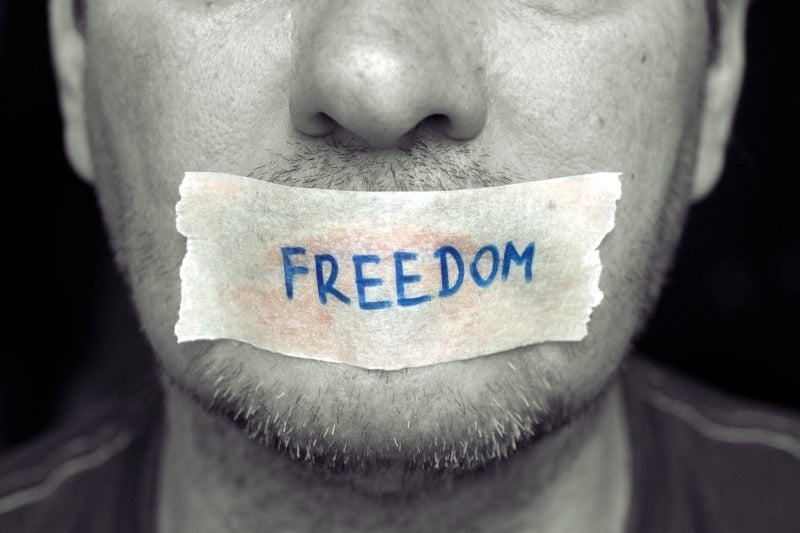
The Toronto professor ignited the tensions and complexities of contemporary society. And his refusal to address a transgender person with their chosen pronoun. Peterson claimed that the bill was a violation of free speech on which Western civilization was built. Mr. Peterson faced no charges for falling foul of the Ontario Human Rights Code . Legal experts argued his refusal to use chosen pronouns was not sufficient to meet the grounds of hate speech.
Gambling and casinos have become commonplace in Canada since it was legalized in 1969 . Slot machines, video lottery terminals, sports bookies, animal racing, and casinos are prevalent.
And allow Canadians to try their luck in a fair and legal game of chance. While popular with many, there are plenty of Canadians who would never buy a lottery ticket.

They consider the pastime to be low class. And those who cannot plan and “ make their luck in life “ through hard work and smarts. They may have a point, as the thrill of gambling is addictive.
It’s now one of the current social issues in Canada being tackled. In particular, with the increase of online gambling , the activity has now become problematic . Support groups are now springing up to help those addicted. And even rehab is required to treat those who are severely affected. Fortunately, large Canadian online casinos, such as the well-known Casinovalley.ca, are aware of their responsibility and provide their players with the Canadian Gambling Addiction Help Guide.
Family violence is one of the most complex issues facing families and communities in Canada, and its consequences can be far-reaching. Statistics on this violence in Canada are on an upward trend, mainly due to increased crimes against children and youth . Since 2016, these statistics have begun to rise again, until 2019.
Prior to that, the rate declined by nearly 19% between 2009 and 2016. Similarly, a global pandemic has been cited as one of the problems.
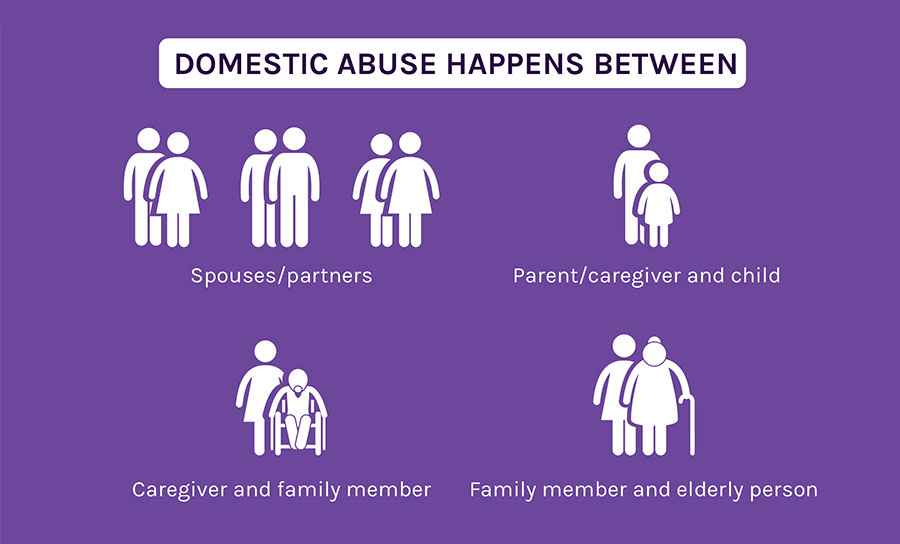
However, between March and October 2020 , the number of some criminal incidents dropped again. At the same time, threats against family members increased by 2%. Police reports describe trends in family violence, including rates of spousal violence against women and the elderly, and in some cases, men.
Violence against women remains one of the current social issues in Canada.
Approximately 25% of violent crime reported to Canadian police is family abuse.
The Canadian Women’s Foundation estimates that over 6,000 women and children sleep in shelters every night, while a further 300 are turned away. First nation Canadians are around six times more likely to be killed by their partner than non-indigenous Canadian women. And one Canadian woman is killed every six days by an intimate partner.

These statistics highlight a social issue in Canada that is still a major concern. The CWF says even more work needs to be done . Examples of such action to improve this social issue include early intervention of reporting crime. Attitudes towards women and available support services also need to improve.
The selling of sex is often considered to be the first trade. But as in Canada and with other nations, it is one of the social problems that is deemed to be taboo . The selling of sex is highly stigmatized in Canada . And it is considered the domain of the impoverished and drug addicts. Sex workers are often abused by pimps, physically and economically, despite this being illegal.

Charitable groups in Canada have stepped in to help some of these sex workers escape their social problems. But many view the “improvement” of conditions for sex workers as a move towards normalizing an offensive trade.

Drugs and alcohol are a part of virtually every society. Like other nations, in Canada, legislators have grappled with one of the most challenging social issues there is. In twentieth-century Canada, prohibition was used to tackle this most contentious of social problems.
Most drinkers not native to Canada would likely be baffled and annoyed by the restrictions on the sale of alcohol .
Conversely, marijuana possession has been legal since 2018.
Visiting smokers to Canada would be impressed and delighted by the pot shops, which can be found in urban areas.
Despite today’s opioid crisis, the government is not eager to crack down on unlicensed sources of marijuana sales. So during 2020 , more than 1,500 people died of overdoses.

The reason for this may well be that only about 30% of Canadians who use marijuana buy it from legal stores. The rest, however, prefer both legal and unlicensed establishments .
Racial discrimination against the first nations has been one of the ongoing social issues faced by generations in Canada. The indigenous population is still facing social and economic problems in Canada.
At the same time, other Canadians and immigrants prosper. When it comes to social issues, the first nations population of Canada suffers high rates of social problems. These include incarceration, poverty, unemployment, suicide, addiction, and health issues.
The rights of indigenous people and the desires of the industries such as oil are often in stark conflict. Many of these problems are rooted in racism and discrimination owing to current high levels of poverty. While the government may have accepted responsibility for injustices, the issue remains.

Similarly to the US, in Canada, hunting is popular, but the possession of firearms is one of their most divisive social issues. Owning a gun is far less sport, and more so a necessity, with bear attacks still possible in rural areas. Conversely, as much as a weapon is a defence against wild animals, gun massacres are still prevalent in Canada.
In 2018 , ten people were killed in the Toronto van attack; a further two killings happened later in the year. Four shootings were recorded in 2019 , which bolsters the argument of those against gun ownership.
More recently, on May 29, 2021, a man was shot and killed. According to the police press service, it all happened in Montreal, and he was 22 years old. Also, law enforcement officials confirmed to reporters that this is the 10th murder since the beginning of 2021.
Around seven million Canadians own guns and are recreational hunters.
But typical city-dwelling Canadians disapprove of guns. They point to gang violence and massacres as the reasons for the outlawing of gun ownership in the nation .
So, as of May 1 , 2020 , Prime Minister Justin Trudeau confirmed that a ban on the possession of assault weapons would be enforced. More than a thousand weapon types have been added to the list. However, despite this law, the number of murders with firearms has not decreased significantly.

Canada does have rigorous checks in place for gun licenses and ownership. Unlike the US, automatic and semi-automatic guns are banned. So, when an unfortunate massacre occurs in Canada, the numbers murdered are usually in single digits.
In Canada, there are nearly five million people living in poverty, and it can affect anyone. Poverty affects people of all ages, economic backgrounds, and nationalities. Poverty is a complex issue related to unemployment, return rates on investments, sub-standard housing, health policy, and education.
Despite Canada’s reputation as a prosperous nation, millions of Canadians are still struggling to meet their basic needs. In order for people to get out of poverty, they need help from others and government support. Poverty costs us all because it results in high-stress levels, poor health outcomes, social exclusion and lower educational achievement. People’s potential is often limited in these ways.
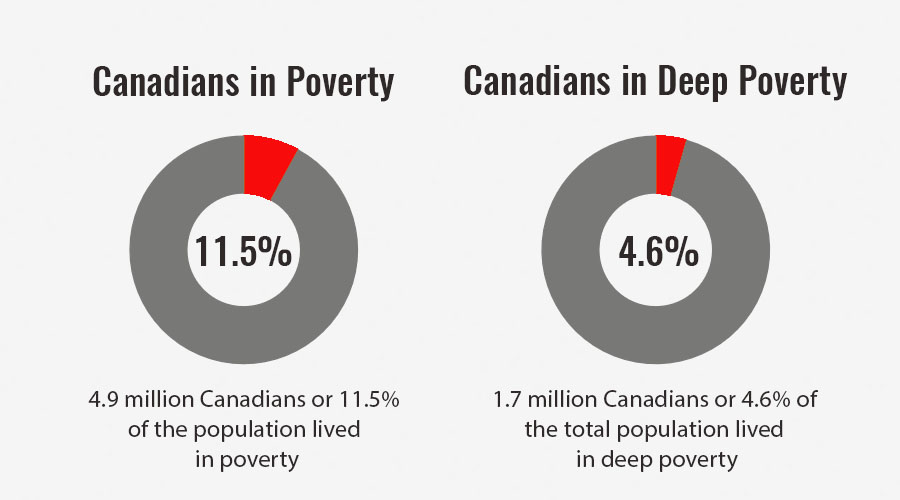
Here are some statistics to date :
- 4.9 million are below the poverty line.
- 1.7 million or almost 5% of the total Canadian population, live in deep poverty.
- Job insecurity has increased by 50% in the last 20 years.
- Even though the population has increased by a third in the last 25 years, investment in housing has declined.

The ageing population means that pension benefits are another of the major social issues affecting those in Canada today. In the past, those contributing to pensions and those receiving the benefit resembled a triangle.
The base of the triangle represents a steady source of contributors and those accessing pensions being far fewer. Now, the triangle is upended.
Many younger people are not contributing as they are part of the freelance “ gig ” economy. And those relying on the benefit are living for decades past the age of sixty-five. The math simply doesn’t add up when the population relies on state income for a period almost as long, if not longer, than the time spent contributing.
Canadians face the same uphill struggle as other nations to try and meet the demands of an ageing population . The pension system in Canada allows for nationals and non-nationals who have resided in the country for more than ten years to receive a pension.
The amount allocated is dependent on the amount paid into the fund; the minimum amount is less than $740 and the maximum amount around $1200 as of 2021. This amount would leave many in relative poverty. The minimum amount is around $100 more than the maximum unemployment paid.
In Canada, politicians, strategists, and economists are looking for solutions for what is one of the major social problems of our time.

Although the expression and experience of these social issues vary significantly, resolving them will improve the lives of every Canadian.
The Complex Social Issues Facing Canadians
Family Service Canada member agencies respond to the issues that undermine family and individual well-being.
The issues explored below often intersect adding complexity and contributing to the challenge of resolving them. More than that, outdated social ideas often blame the victims and dismiss the impact. The resulting shame and stigma can make individuals less likely to reach out for support—deepening or prolonging the challenges.
The Impact is not Small
Those who face the issues below bear the immediate physical, mental, and emotional costs. And there are almost certainly more Canadians directly affected than we know. But the costs of these issues extend to every Canadian.
There are government and system costs associated with support, and the affected individuals are typically less able to participate in the workforce and economy. The research highlighted below shows that failing to respond caries a staggering cost to businesses, institutions, and the economy. As community-based social service agencies our task is twofold:
- To support the families who face these issues directly; and
- To help Canadians understand the significant impact and cost of leaving these issues unaddressed.
To learn more about how our members respond, visit their websites. You’ll find links on our Current Members page.
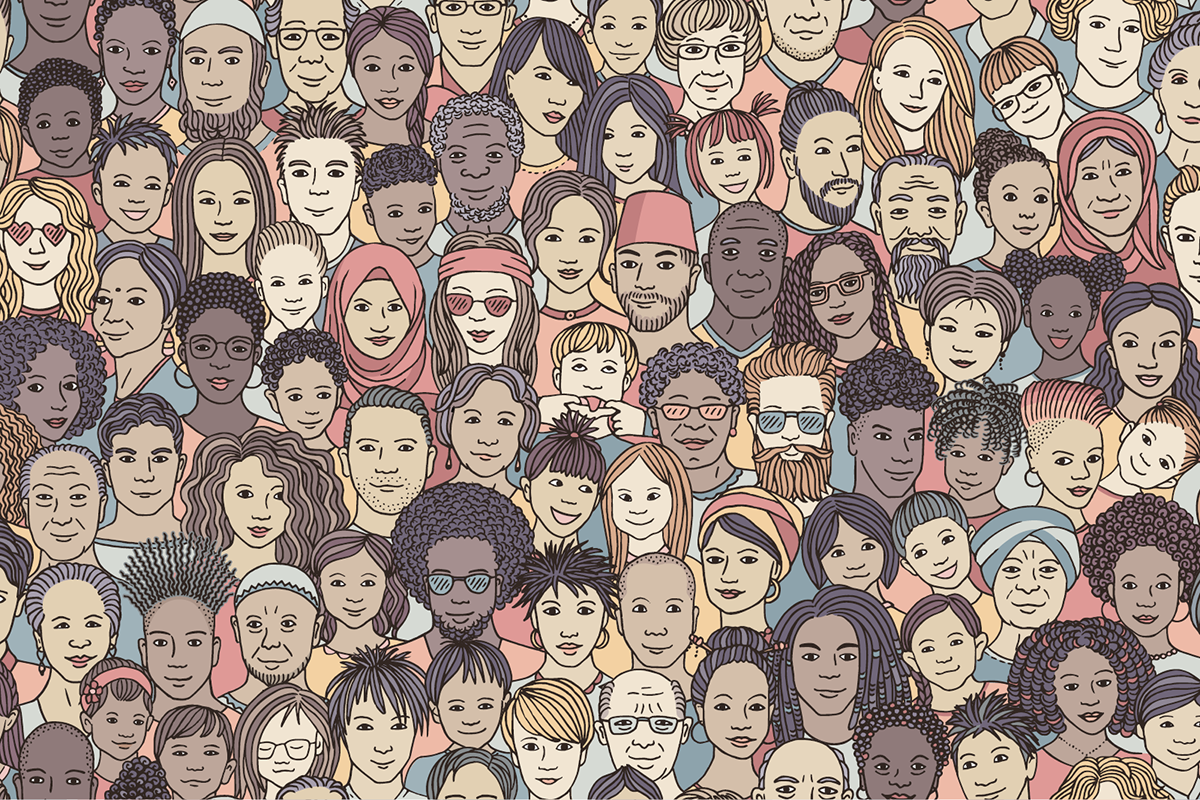
Jump to an Issue
Family violence.
- Mental Health and Addictions
Social Exclusion
“The condition of a person who is deprived of the resources, means, choices and power necessary to acquire and maintain a basic level of living standards and to facilitate integration and participation in society.”
- Government of Canada
Canadians in Poverty
In 2018, 3.2 million Canadians or 8.7% of the population lived in poverty.
Canadians in Deep Poverty
1.7 million Canadians or 4.6% of the total population lived in deep poverty—having disposable income below 75% of Canada’s Official Poverty Line.
Why it Matters
Poverty affects community strength and resilience. People living in poverty are more likely to face health issues, have difficulty finding and keeping a job, find themselves in the criminal justice system, and need various social supports.
Identifying the social cost of poverty is notoriously tricky. The impact is spread across our criminal justice, health, social support systems, and every level of government. Beyond that, there are economic costs: families without money cannot buy products or services.

Statistics Canada, Dimensions of Poverty Hub . https://www.statcan.gc.ca/eng/topics-start/poverty
Employment and Social Development Canada, Opportunity for All: Canada’s First Poverty Reduction Strategy . https://www.canada.ca/en/employment-social-development/programs/poverty-reduction/reports/strategy.html
Association of Ontario Foodbanks, The Cost Of Poverty: An Analysis of the Economic Cost of Poverty in Ontario . https://feedontario.ca/wp-content/uploads/2016/08/CostofPoverty.pdf
Back to Top ∧
Family violence describes any form of abuse, mistreatment, or neglect that a child or adult experiences from a family member, or from someone with whom they have an intimate relationship.
Victims of police-reported violent crime
In 2016, one‑quarter (26%) of all victims of violent crime had been victimized by a family member.
Female Victims of Family Violence
While women and girls made up just over half (52%) of violent crime victims overall, two‑thirds (67%) of family violence victims were female.
The known rate of family violence is likely underestimated.
Self‑reported data from the 2014 General Social Survey on Canadians’ Safety (Victimization) show that 70% of victims of spousal violence and 93% of victims of childhood physical and/or sexual abuse never spoke to authorities about their experiences.
Family violence can cause a range of short and long-term health issues, including physical, mental, cognitive, and behavioural challenges. It can contribute to poverty, housing instability, and school failure, but individuals who experience these conditions are also at greater risk for intimate violence.
Beyond the personal costs, family violence has implications for our health and justice systems, employers, businesses, as well as social and community services. Like poverty, the total cost is difficult to calculate. A study completed in 2012 suggested $7.4 billion per year. The authors cautioned that value was underestimated because of data availability and the under-reporting of family violence.
Stats Canada, Family Violence in Canada: A Statistical Profile, 2016. https://www150.statcan.gc.ca/n1/pub/85-002-x/2018001/article/54893-eng.htm
Public Health Agency of Canada, The Health and Social Impacts of Family Violence . https://www.canada.ca/en/public-health/services/health-promotion/stop-family-violence/health-social-impacts-family-violence.html
Government of Canada, An Estimation of the Economic Impact of Spousal Violence in Canada, 2009 . https://www.justice.gc.ca/eng/rp-pr/cj-jp/fv-vf/rr12_7/index.html
Mental Health Issues & Addictions
Mental health and well-being affect every aspect of life, including our ability to engage with and contribute to our families and communities. Disorders affect mood, thinking, and behaviour, including depression and anxiety, substance abuse disorders and process addictions like gambling.
Canadian Mental Health 1
Mental illness is estimated to take 10 to 20 years off an individual’s life expectancy. As of 2016, an average of 10 Canadians die by suicide each day. It’s the second leading cause of death for Canadians 10 to 29 years of age.

Canadian Association of Mental Health, Mental Illness and Addiction: Facts and Statistics . https://www.camh.ca/en/driving-change/the-crisis-is-real/mental-health-statistics
Public Health Agency of Canada, Suicide in Canada. https://www.canada.ca/en/public-health/services/publications/healthy-living/suicide-canada-infographic.html
Mental Health Commission of Canada, The Life and Economic Impact of Major Mental Illnesses in Canada . https://www.mentalhealthcommission.ca/sites/default/files/MHCC_Report_Base_Case_FINAL_ENG_0_0.pdf
Racism is the belief that a particular race is superior or inferior to another and, based on that, actively or passively supports discrimination, prejudice and violence against another person.
Related Blog Posts
Statement on residential schools, become an antiracist organization, canadian ancestry.
On the 2016 census, Canadians reported over 250 ethnic origins or ancestries.
Hate Crimes Motivated by Ethnicity
Forty-four percent of police-reported hate crimes in 2018 were motivated by race or ethnicity.
In 2018, police reported 1,798 criminal incidents in Canada motivated by hate, which is not exclusive to racism. As with other topics on this page the data is incomplete. As a comparison, the 2014 General Social Survey on Canadian's Safety, Canadians self-reported over 330,000 hate-motivated criminal incidents in the year leading up to the survey. Two-thirds of these incidents were never reported to the police.
Racism has clear, and sometimes deadly consequences for Canadians. It also has costs to our justice system and hinders our economy and exacerbates poverty. Racialized Canadians earn, on average, 81 cents to the dollar compared to other Canadians. Employers are also about 40% more likely to interview a job applicant with an English-sounding name despite identical education, skills, and experience.
These impacts become more significant when race intersects with other targeted identities, such as gender and sexual orientation.
Stats Canada, Ethnic and cultural origins of Canadians: Portrait of a rich heritage . https://www12.statcan.gc.ca/census-recensement/2016/as-sa/98-200-x/2016016/98-200-x2016016-eng.cfm
Stats Canada, Police-reported Hate Crime in Canada . https://www150.statcan.gc.ca/n1/pub/85-002-x/2020001/article/00003-eng.htm
Canadian Human Rights Commission, Racial, Ethnic and Religious Rights . https://www.chrc-ccdp.gc.ca/eng/content/religious-rights
Social exclusion is a denial of belonging or recognition. The intent is to keep people and communities distanced from centres of power and resources. It leaves people economically and socially vulnerable.
Social exclusion is usually driven by greed and prejudice. Excluding others ensures your group has access to more of the resources you want with limited competition. A social understanding of exclusion is relatively new, and we lack statistical data on its pervasiveness, but Canadians are becoming more aware of it.
Racism can be the basis for social exclusion. The anti-racism protests in 2020 called for changes to policy that disproportionately disadvantaged people of colour, especially related to the justice system. The policies they pointed to are a form of social exclusion.

Canadian Council on Social Development, Social Challenges: Social Exclusion . https://www.ccsd.ca/resources/CrimePrevention/c_exclusion.htm
Social Planning Council of Peel, Social Exclusion of Minority Groups: A Conceptual Framework . https://www.spcottawa.on.ca/sites/all/files/pdf/2008/Publications/Social-Exclusion-Conceptual-%20Framework.pdf
Share your knowledge to help us understand the issues facing Canadian families!
We’ll do the same for you.
Family Service Canada
Our mission is to promote learning and the exchange of expertise through the dynamic relationships between executive leaders of family-serving organizations in Canada.
Our vision is to be a vibrant network of exceptional family serving organizations building capacity in communities across Canada.
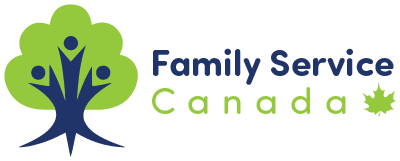
Privacy Policy
Family Service Canada is a registered Canadian charity || Charitable Number: 11891-3052-RR0001
© Family Service Canada, 2024
Social Analysis in Canada Essay (Critical Writing)
In getting started on social analysis in canada.
Clarke, Czerny, Davies and Swift explain that the Third World conditions experienced in the southern countries (Third World countries) are as a result of unfair economic constitutions adopted by the rich nations, which are the US and the Western European countries (110). They argue that although international exchanges of ideas of arguably everything have increased, leading to faster flow of money, goods, people and information (Cairns and Sears 243), rich nations have taken advantage of their superiority to trample on the developing countries.
This, they explain, is as a result of unequal financial, as well as, trade relations. I completely agree with this assertion, based on the economic policies adopted by the World Trade Organization, International Monetary Fund and the World Bank where the rich nations are the major shareholders and signatories (UN Development Programme 2).
In my view, the rich nations in Western Europe and North America are responsible for the economic problems experienced in Third World countries. The global trade and commerce has not been able to generate the economic growth essential for the development of the Third World countries, while the rich nations continue to achieve significant economic growth and development (Shah 2).
Third World countries have been turned to beggars and highly depend on the rich nations for financial assistance. The enormous debts that they owe to rich nations have become the main obstacle to achieving human development and economic stability. According to Clarke, Czerny, Davies and Swift, poor countries pay more in debt services as compared to what they receive from loans (110).
Rich nations siphoned-off massive resources from Third World countries during the colonial period, and to further cement their economic power and growth, adopted economic policies that allow them to scoop more wealth from these countries. The rich nations have sometimes imposed loans on Third World countries so that they can achieve their interests, thereby increasing the debt burden on poor countries (Shah 8).
These unfair debts which result from illegitimate loans destabilize the economic growth of poor countries considering the high interest rates that they repay the loans with. Rich nations therefore get richer while poor nations only achieve minimal economic growth. Clarke, Czerny, Davies and Swift advocate for development based democracy and fair dealing (110).
While it is important to create economic institutions for the growth of a country or the world as a whole, the provisions of international economic constitutions should not favor the rich nations at the expense of the poor nations. The international economic and financial institutions such as IMF and World Bank have been instituted in such a way that the rich nations from North America and Western Europe control and scoop wealth from the poor countries.
Third World countries are forced to play along the rules created by rich nations or else they risk economic alienation or sanction even though these economic policies have more disadvantage to them than advantages. I take the example of Ethiopia where the IMF suspended financial aid due to its rejection of the one-size-fits-all development model adopted by the organization, at a time when the country lagging at the 170 th position on the UN list (Clarke, Czerny, Davies and Swift 111-112).
Liberalization of markets and privatization policies further worsens the ability of poor countries to achieve significant economic stability. Rich nations have not allowed poor countries to stabilize their economies before they adopt the liberalization and privatization policies. In my view, this is the major reason as to why rich nations continue to unfairly drain off resources from poor countries to develop their own economies.
It is now several decades ranging from 6 to 3 since most of these poor countries attained independence from colonial control, and yet they are still not ready to compete favorably in global trade and commerce with the rich nations. This means that they were ambushed to adopt these policies. The former chief economist of the World Bank, Joseph Stiglitz, argues that IMF and the World Bank have adopted economic policies which push governments of poor countries away from controlling their internal markets claiming that free-market capitalism would help these countries solve their economic problems (Clarke, Czerny, Davies and Swift 110).
Today, the markets are controlled by demand and supply, as well as competition and not governments. Rich nations therefore take advantage of the poor countries by expanding their already established companies to developing economies. They quickly control the markets in such countries ahead of the domestic industries, yet the revenue collected in the process is repatriated. Clarke, Czerny, Davies and Swift are also share my view that the financial liberalization advocated for by the rich nations and international institutions such as the IMF and the World Bank unfairly benefit the economies of rich nations (111).
It limits ability of the poor countries to establish protectionist measures for their not yet stable financial markets and therefore opening them up to free-market economics. Poor countries no longer have the capacity to control the financial markets, meaning that they can not influence productivity, jobs, as well as, the prices of imports and exports.
I strongly believe that the economic policies applied by the rich nations and the international agreements which they make with the rich nations, have got nothing to do with achieving global economic growth. These policies and agreements are meant to achieve protectionism to their domestic products and companies, and to expand the market for their commodities and services.
The mutual benefits in these relationships are skewed and highly favour them. Clarke, Czerny, Davies and Swift (119-120) explain that some rich nations have occasionally applied technical barriers to limit trade abilities of other nations. Such governments have always quoted worker, consumer or environmental protection as their reasons for banning the importation of some products.
In my view, these are protectionist measures adopted to protect their economic interests. Canada has been forced to sign many international economic agreements to satisfy the economic interests of the US, and the World Trade Organization to benefit from the trade and economic relations with the US and Western European countries (Naiman 126). Rich nations normally sign agreements which have more trade benefits to them and which result to trade creation on their side more than it does to developing countries.
The market economics programs of liberalization, as well as, privatization which have controlled the new era of globalization are questionable. They have unfairly given rise to development for the US and the Western European countries.
I therefore conclude that development as a result of globalization should not just consider economic growth, but should be made sustainable, and participatory. There should also be checks on the free market particularly by Third World countries. Besides, there should be liberty to participate effectively and equally in trade and commerce.
Works Cited
Cairns, James and Sears, Alan. A Good Book. In Theory Making Sense Through Inquiry , 2 nd Ed. Toronto: University of Toronto Press, 2010. Print.
Czerny, Michael, ]ackline, Clarke, Davies, Robert, and Swift, Jamie. Globalization and development. In getting started on social analysis in Canada , 4th ed. Toronto, ON: Between the Lines, 2003. Print.
Naiman, Joan. How Societies Work: Class, Power, And Change In A Class, Power, And Change In A Canadian Context , 4th Ed. Fernwood Publishing Company Ltd, 2008. Print.
Shah, Anup . Causes of Poverty . Global Issues, 2011. Web.
UN Development Programme. Human Development Report 1999 . New York: Oxford University Press, 1999. Print.
- Chicago (A-D)
- Chicago (N-B)
IvyPanda. (2023, December 19). Social Analysis in Canada. https://ivypanda.com/essays/social-analysis-in-canada/
"Social Analysis in Canada." IvyPanda , 19 Dec. 2023, ivypanda.com/essays/social-analysis-in-canada/.
IvyPanda . (2023) 'Social Analysis in Canada'. 19 December.
IvyPanda . 2023. "Social Analysis in Canada." December 19, 2023. https://ivypanda.com/essays/social-analysis-in-canada/.
1. IvyPanda . "Social Analysis in Canada." December 19, 2023. https://ivypanda.com/essays/social-analysis-in-canada/.
Bibliography
IvyPanda . "Social Analysis in Canada." December 19, 2023. https://ivypanda.com/essays/social-analysis-in-canada/.
- Charlotte Davies’ Virtual Environment Osmose
- "Philosophy of Religion" by Brian Davies
- Media Arts: Char Davies' Osmose Virtual Environment
- Search of Identity in "The Manticore" and "World of Wonders" by Robertson Davies
- Multimedia Art: Osmose Environment by Char Davies
- Clarke's Cosmological Argument
- Char Davies' Osmose as Virtual Reality Environment
- Chapter 1 of "Managerial Economics" by Davies & Lam
- Word Choice in "The Curse" by Arthur C. Clarke
- Char Davies' Osmose as Digital Media Art
- Israel Palestine Conflict
- American Foreign Policy in Middle East
- Possibilities and Limitations of Creating Civil Society though International Donor Funding
- United Nations Peacekeeping Operation in Northern Africa
- Steps Taken To Reduce Nuclear Weapons
- Free Samples
- Premium Essays
- Editing Services Editing Proofreading Rewriting
- Extra Tools Essay Topic Generator Thesis Generator Citation Generator GPA Calculator Study Guides Donate Paper
- Essay Writing Help
- About Us About Us Testimonials FAQ
- Studentshare
- Social issues in canada
Social issues in canada - Essay Example

- Subject: English
- Type: Essay
- Level: Masters
- Pages: 2 (500 words)
- Downloads: 4
- Author: zmoen
Extract of sample "Social issues in canada"
Social issues in Canada Currently, one of the elements that define the Canadian identity is the social policies of Canada. These are the different regulations and laws governing how individuals in Canada live and the benefits offered by the government. These social policies are specifically seen to make Canada a progressive and distinctive nation. This paper will talk on abortion, healthcare, drug & alcohol and guns as the major social policies implemented in Canada.AbortionIn the previous years, Canada has abruptly changed from being a pro-life nation in the world to a pro-choice nation.
As the nation has a lot of Catholic individuals, any kind of abortion was not tolerated. From 1969, abortion was permitted in the event when the life of a mother is said to be at risk. Illegal abortions were still done and in 1988, Dr. Henry Morgentaler, an abortionist was faced with abortion charges. Finally, the court ruled that the present abortion regulations in Canada epitomized an unconstitutional burden on women rights. This made the law to be upended (McCullough, 2014). Even though the Canadian Supreme Court allowed for other limits on abortion, the government of Canada has never approved any of the limits.
Women in Canada are at liberty to abort and it is seen to be a degree of laxity that has not been seen in any part of the western world. Health CareThe Canadian health care system is seen to be functioning properly and liked by most individuals for the services they provide. Since 1960s, the Canadian government started a slow process of removing out the profit making health clinics, hospitals and insurance. They were later replaced with universal, new and health care system funded by the government.
Currently, every individual in Canada is offered comprehensive health insurance without requesting. This is done by the use of public health coverage plans that different provincial governments run (McCullough, 2014). It means that every Canadian individual does not need to pay for his/her medical bills or depend on their employers for any health insurance. A small amount on monthly premiums is charged by the government while it steps in to clear the majority of the bill for operations, check-ups and exams.
It is not easy to maintain a health care system. Currently, many Canadian individuals need to purchase supplementary private health insurance required in paying for eye examinations, operations termed as non-essential by the government and dentist examinations. Likewise, hospitals in Canada mostly have a lot of patients because they are accessed easily. This makes the individuals to wait for long durations so that one can see a specialist (McCullough, 2014). Drug & AlcoholIn early Canada, alcohol was linked with different types of social ills.
The legal drinking age in Canada is mostly between 18 – 19 years depending on the province. Different provinces have harsh laws against taking alcohol in public places and driving when drunk (McCullough, 2014). In Canada, hard drugs are not legal. Currently, the jail time for drug users, dealers and traffickers has been increased.GunsThe rate of gun ownership in Canada has been on the increase, specifically in rural areas as the nation has the traditions of trapping and hunting. The Canadian National Firearms Association has revealed that close to 21 million guns are owned by approximately seven million individuals in Canada (McCullough, 2014).
Majority of these individuals are hunters. In Canada, gun control is seen to be a critical issue. Individuals living in urban centers, guns are linked with crime thus controlling the possession of gun is high. Individuals living in rural areas use guns in sport shooting and hunting. ConclusionDrugs & alcohol are seen to be one point of exit. The lower house of parliament in Canada is amending a bill to legalize small amounts of marijuana. On the other hand, the current Canadian politics has been debating on the health care system.
There are critics who do not want the two-tiered system to be implemented. This is because individuals with money could get better medical facilities rather than the ones using the public system. Currently, abortion is a debated topic. There are activists making demonstrations in making sure that their sentiments are heard.Work CitedMcCullough, J.J. “Social Issues in Canada.” J.J.’s Complete Guide to Canada. N.P.,2014.Web. 07. Nov. 2014.
- Cited: 0 times
- Copy Citation Citation is copied Copy Citation Citation is copied Copy Citation Citation is copied
CHECK THESE SAMPLES OF Social issues in canada
The major issues being faced by immigrants in canada, social policy and practice in canada by alvin finkel, the issue of poverty in canada, the concept of social variables, the measurement of poverty in canada, analysis of multiculturalism in canada, the aboriginal healing movement - aboriginal peoples of canada, prostitution a social issue in canada.

- TERMS & CONDITIONS
- PRIVACY POLICY
- COOKIES POLICY
Essay On Social Issues
500 words essay on social issues.
Social Issues is an undesirable state which opposes society or a certain part of society. It refers to an unwanted situation that frequently results in problems and continues to harm society . Social issues can cause a lot of problems that can be beyond the control of just one person. Through an essay on social issues, we will learn why they are harmful and what types of social issues we face.

Drawbacks of Social Issues
Social issues have a lot of drawbacks that harms our society. They are situations that have an adverse and damaging result on our society. They arise when the public leaves nature or society from an ideal situation.
If you look closely, you will realize that almost all types of social issues have common origins. In the sense that they all are interconnected somehow. Meaning to say, if one solves the other one is also most likely to resolve.
Social issues have a massive lousy effect on our society and ultimately, it affects all of us. In order to solve some social issues, we need a common approach. No society is free from social issues, almost every one of them has some social issue or the other.
For instance, in India, you will find a lot of social issues which the country is facing. It ranges from the caste system to child labour and gender inequality to religious conflicts. Thus, we are going through a critical time where we all must come together to free our society from undesirable social evils.
Get the huge list of more than 500 Essay Topics and Ideas
Major Social Issues
There are a lot of social issues we are facing right now, some more prominent than the others. First of all, poverty is a worldwide issue. It gives birth to a lot of other social issues which we must try to get away with at the earliest.
Further, countries like India, Nepal, Bangladesh, Sri Lanka, Pakistan and more are facing the issue of the caste system since times unknown. It results in a lot of caste violence and inequality which takes the lives of many on a daily basis.
Moreover, child labour is another major social issue that damages the lives of young children. Similarly, illiteracy also ruins the lives of many by destroying their chances of a bright future.
In developing countries mostly, child marriage still exists and is responsible for ruining many lives. Similarly, dowry is a very serious and common social issue that almost all classes of people partake in.
Another prominent social issue is gender inequality which takes away many opportunities from deserving people. Domestic violence especially against women is a serious social issue we must all fight against.
Other social issues include starvation, child sex abuse, religious conflicts, child trafficking, terrorism , overpopulation, untouchability, communalism and many more. It is high time we end these social issues.
Conclusion of the Essay on Social Issues
A society can successfully end social issues if they become adamant. These social issues act as a barrier to the progress of society. Thus, we must all come together to fight against them and put them to an end for the greater good.
FAQ on Essay on Social Issues
Question 1: What is the meaning of social problem?
Answer 1: A social problem refers to any condition or behaviour which has a negative impact on a large number of people. It is normally recognized as a condition or behaviour that needs to be addressed.
Question 2: What are the effects of social issues?
Answer 2: Social issues affect our society adversely. Most importantly, it disturbs the harmony of society and gives rise to hostility and suspicion. Moreover, it creates large-scale social dissatisfaction, suffering and misery.
Customize your course in 30 seconds
Which class are you in.

- Travelling Essay
- Picnic Essay
- Our Country Essay
- My Parents Essay
- Essay on Favourite Personality
- Essay on Memorable Day of My Life
- Essay on Knowledge is Power
- Essay on Gurpurab
- Essay on My Favourite Season
- Essay on Types of Sports
Leave a Reply Cancel reply
Your email address will not be published. Required fields are marked *
Download the App

- Share full article
Advertisement
Supported by
NPR in Turmoil After It Is Accused of Liberal Bias
An essay from an editor at the broadcaster has generated a firestorm of criticism about the network on social media, especially among conservatives.

By Benjamin Mullin and Katie Robertson
NPR is facing both internal tumult and a fusillade of attacks by prominent conservatives this week after a senior editor publicly claimed the broadcaster had allowed liberal bias to affect its coverage, risking its trust with audiences.
Uri Berliner, a senior business editor who has worked at NPR for 25 years, wrote in an essay published Tuesday by The Free Press, a popular Substack publication, that “people at every level of NPR have comfortably coalesced around the progressive worldview.”
Mr. Berliner, a Peabody Award-winning journalist, castigated NPR for what he said was a litany of journalistic missteps around coverage of several major news events, including the origins of Covid-19 and the war in Gaza. He also said the internal culture at NPR had placed race and identity as “paramount in nearly every aspect of the workplace.”
Mr. Berliner’s essay has ignited a firestorm of criticism of NPR on social media, especially among conservatives who have long accused the network of political bias in its reporting. Former President Donald J. Trump took to his social media platform, Truth Social, to argue that NPR’s government funding should be rescinded, an argument he has made in the past.
NPR has forcefully pushed back on Mr. Berliner’s accusations and the criticism.
“We’re proud to stand behind the exceptional work that our desks and shows do to cover a wide range of challenging stories,” Edith Chapin, the organization’s editor in chief, said in an email to staff on Tuesday. “We believe that inclusion — among our staff, with our sourcing, and in our overall coverage — is critical to telling the nuanced stories of this country and our world.” Some other NPR journalists also criticized the essay publicly, including Eric Deggans, its TV critic, who faulted Mr. Berliner for not giving NPR an opportunity to comment on the piece.
In an interview on Thursday, Mr. Berliner expressed no regrets about publishing the essay, saying he loved NPR and hoped to make it better by airing criticisms that have gone unheeded by leaders for years. He called NPR a “national trust” that people rely on for fair reporting and superb storytelling.
“I decided to go out and publish it in hopes that something would change, and that we get a broader conversation going about how the news is covered,” Mr. Berliner said.
He said he had not been disciplined by managers, though he said he had received a note from his supervisor reminding him that NPR requires employees to clear speaking appearances and media requests with standards and media relations. He said he didn’t run his remarks to The New York Times by network spokespeople.
When the hosts of NPR’s biggest shows, including “Morning Edition” and “All Things Considered,” convened on Wednesday afternoon for a long-scheduled meet-and-greet with the network’s new chief executive, Katherine Maher , conversation soon turned to Mr. Berliner’s essay, according to two people with knowledge of the meeting. During the lunch, Ms. Chapin told the hosts that she didn’t want Mr. Berliner to become a “martyr,” the people said.
Mr. Berliner’s essay also sent critical Slack messages whizzing through some of the same employee affinity groups focused on racial and sexual identity that he cited in his essay. In one group, several staff members disputed Mr. Berliner’s points about a lack of ideological diversity and said efforts to recruit more people of color would make NPR’s journalism better.
On Wednesday, staff members from “Morning Edition” convened to discuss the fallout from Mr. Berliner’s essay. During the meeting, an NPR producer took issue with Mr. Berliner’s argument for why NPR’s listenership has fallen off, describing a variety of factors that have contributed to the change.
Mr. Berliner’s remarks prompted vehement pushback from several news executives. Tony Cavin, NPR’s managing editor of standards and practices, said in an interview that he rejected all of Mr. Berliner’s claims of unfairness, adding that his remarks would probably make it harder for NPR journalists to do their jobs.
“The next time one of our people calls up a Republican congressman or something and tries to get an answer from them, they may well say, ‘Oh, I read these stories, you guys aren’t fair, so I’m not going to talk to you,’” Mr. Cavin said.
Some journalists have defended Mr. Berliner’s essay. Jeffrey A. Dvorkin, NPR’s former ombudsman, said Mr. Berliner was “not wrong” on social media. Chuck Holmes, a former managing editor at NPR, called Mr. Berliner’s essay “brave” on Facebook.
Mr. Berliner’s criticism was the latest salvo within NPR, which is no stranger to internal division. In October, Mr. Berliner took part in a lengthy debate over whether NPR should defer to language proposed by the Arab and Middle Eastern Journalists Association while covering the conflict in Gaza.
“We don’t need to rely on an advocacy group’s guidance,” Mr. Berliner wrote, according to a copy of the email exchange viewed by The Times. “Our job is to seek out the facts and report them.” The debate didn’t change NPR’s language guidance, which is made by editors who weren’t part of the discussion. And in a statement on Thursday, the Arab and Middle Eastern Journalists Association said it is a professional association for journalists, not a political advocacy group.
Mr. Berliner’s public criticism has highlighted broader concerns within NPR about the public broadcaster’s mission amid continued financial struggles. Last year, NPR cut 10 percent of its staff and canceled four podcasts, including the popular “Invisibilia,” as it tried to make up for a $30 million budget shortfall. Listeners have drifted away from traditional radio to podcasts, and the advertising market has been unsteady.
In his essay, Mr. Berliner laid some of the blame at the feet of NPR’s former chief executive, John Lansing, who said he was retiring at the end of last year after four years in the role. He was replaced by Ms. Maher, who started on March 25.
During a meeting with employees in her first week, Ms. Maher was asked what she thought about decisions to give a platform to political figures like Ronna McDaniel, the former Republican Party chair whose position as a political analyst at NBC News became untenable after an on-air revolt from hosts who criticized her efforts to undermine the 2020 election.
“I think that this conversation has been one that does not have an easy answer,” Ms. Maher responded.
Benjamin Mullin reports on the major companies behind news and entertainment. Contact Ben securely on Signal at +1 530-961-3223 or email at [email protected] . More about Benjamin Mullin
Katie Robertson covers the media industry for The Times. Email: [email protected] More about Katie Robertson
The Definitive Voice of Entertainment News
Subscribe for full access to The Hollywood Reporter
site categories
Lily gladstone and riley keough dm’d about indigenous issues for years before ‘under the bridge’.
The two co-star in the new Hulu series, based on the true story of a 14-year-old girl who was murdered by a group of teenagers in 1997.
By Kirsten Chuba
Kirsten Chuba
Events Editor
- Share this article on Facebook
- Share this article on Twitter
- Share this article on Flipboard
- Share this article on Email
- Show additional share options
- Share this article on Linkedin
- Share this article on Pinit
- Share this article on Reddit
- Share this article on Tumblr
- Share this article on Whatsapp
- Share this article on Print
- Share this article on Comment

The star-studded casting of Lily Gladstone and Riley Keough in Hulu ‘s Under the Bridge , as it turns out, all started in the DMs.
The series, which counts Keough as an executive producer, is based on the true story of Reena Virk, a 14-year-old girl who was beaten and murdered by a group of teenagers in Canada in 1997. Keough stars as Rebecca Godfrey, who investigated and wrote a book on the tragedy, with Gladstone as a local police officer trying to solve the case.
Related Stories
The power of taylor, ryan and zendaya: thr, launchmetrics look at luxury brands that won 2024 awards season, events of the week: 'challengers,' 'abigail' and more.
“I was aware of her work, anyway, but I feel like being in each other’s orbit then, I became very curious about who this talent was. I also was just very taken aback when she started following me on social media — and not just following,” Gladstone told The Hollywood Reporter of Keough. “When I would post about Savanna’s Act , about MMIW (Missing and Murdered Indigenous Women) issues, about an action in Mount Rushmore by Lakota, the ones who have the ancestral rights to the Black Hills — she just started sharing a lot of these social posts that I was making.”
Gladstone continued, “She reached out and asked if I had any recommendations for Indigenous crew she could work with on War Pony [which Keough co-directed in 2022]. We just had a professional knowledge and respect of each other. We were struggling earlier today to remember the moment that we met in person because neither of us remember it, we just kind of feel like we’ve always known each other.”
For her part, Keough said she and Gladstone “just DM’d about random things or responded to each other’s stories, we didn’t say, like, ‘Let’s work together.’ I was such a fan of hers and when you’re a fan of other actors you’re kind of always thinking of them when you’re doing jobs. She was the first person who came to mind for this.”
#RileyKeough and #LilyGladstone pose together for the Hulu premiere of #UndertheBridge pic.twitter.com/M3anajTDBe — The Hollywood Reporter (@THR) April 16, 2024
“And then it turned out that Lily and Riley had been communicating on Instagram and they were looking for something to do together and it was just this beautiful falling of dominoes,” Mehta recalled, joking that in booking them before their respective star turns in Killers of the Flower Moon and Daisy Jones & The Six , “we saw something in those two, they’re going places.”
Talking about why she was drawn to the show, Keough said, “Reena’s story is incredibly important in wanting to honor her and her life. Secondly, there were just themes in this series that I haven’t really seen explored in this genre, like empathy, sort of radical forgiveness, and that was interesting to me.”
The real-life Godfrey — the acclaimed author Keough portrays in the show — died of cancer just weeks before filming began, and the cast pointed to her book as their guiding light throughout the series.
Creator Quinn Shephard, who adapted the story for TV alongside Godfrey, said in beginning production so soon after Godfrey’s death, “I was grieving but in a lot of ways I think getting to go to set like the day after and getting to see the sets being built and bringing her vision to life, it was like getting to spend time with my friend.”
Under the Bridge premieres Wednesday on Hulu.
THR Newsletters
Sign up for THR news straight to your inbox every day
More from The Hollywood Reporter
Ncuti gatwa says while “white mediocrity” gets celebrated, black people must be “flawless” to get half that, ‘bluey’ isn’t done yet: new episode follows “the sign”, bill maher says ‘quiet on set’ made nickelodeon look like “neverland ranch with craft services”, ‘rupaul’s drag race’ crowns winner for season 16, shonda rhimes recalls meeting taylor swift for the first time in her ‘grey’s anatomy’ office, ‘csi: vegas’ and ‘so help me todd’ canceled at cbs.
Numbers, Facts and Trends Shaping Your World
Read our research on:
Full Topic List
Regions & Countries
- Publications
- Our Methods
- Short Reads
- Tools & Resources
Read Our Research On:
Key facts about the abortion debate in America

The U.S. Supreme Court’s June 2022 ruling to overturn Roe v. Wade – the decision that had guaranteed a constitutional right to an abortion for nearly 50 years – has shifted the legal battle over abortion to the states, with some prohibiting the procedure and others moving to safeguard it.
As the nation’s post-Roe chapter begins, here are key facts about Americans’ views on abortion, based on two Pew Research Center polls: one conducted from June 25-July 4 , just after this year’s high court ruling, and one conducted in March , before an earlier leaked draft of the opinion became public.
This analysis primarily draws from two Pew Research Center surveys, one surveying 10,441 U.S. adults conducted March 7-13, 2022, and another surveying 6,174 U.S. adults conducted June 27-July 4, 2022. Here are the questions used for the March survey , along with responses, and the questions used for the survey from June and July , along with responses.
Everyone who took part in these surveys is a member of the Center’s American Trends Panel (ATP), an online survey panel that is recruited through national, random sampling of residential addresses. This way nearly all U.S. adults have a chance of selection. The survey is weighted to be representative of the U.S. adult population by gender, race, ethnicity, partisan affiliation, education and other categories. Read more about the ATP’s methodology .
A majority of the U.S. public disapproves of the Supreme Court’s decision to overturn Roe. About six-in-ten adults (57%) disapprove of the court’s decision that the U.S. Constitution does not guarantee a right to abortion and that abortion laws can be set by states, including 43% who strongly disapprove, according to the summer survey. About four-in-ten (41%) approve, including 25% who strongly approve.

About eight-in-ten Democrats and Democratic-leaning independents (82%) disapprove of the court’s decision, including nearly two-thirds (66%) who strongly disapprove. Most Republicans and GOP leaners (70%) approve , including 48% who strongly approve.
Most women (62%) disapprove of the decision to end the federal right to an abortion. More than twice as many women strongly disapprove of the court’s decision (47%) as strongly approve of it (21%). Opinion among men is more divided: 52% disapprove (37% strongly), while 47% approve (28% strongly).
About six-in-ten Americans (62%) say abortion should be legal in all or most cases, according to the summer survey – little changed since the March survey conducted just before the ruling. That includes 29% of Americans who say it should be legal in all cases and 33% who say it should be legal in most cases. About a third of U.S. adults (36%) say abortion should be illegal in all (8%) or most (28%) cases.

Generally, Americans’ views of whether abortion should be legal remained relatively unchanged in the past few years , though support fluctuated somewhat in previous decades.
Relatively few Americans take an absolutist view on the legality of abortion – either supporting or opposing it at all times, regardless of circumstances. The March survey found that support or opposition to abortion varies substantially depending on such circumstances as when an abortion takes place during a pregnancy, whether the pregnancy is life-threatening or whether a baby would have severe health problems.
While Republicans’ and Democrats’ views on the legality of abortion have long differed, the 46 percentage point partisan gap today is considerably larger than it was in the recent past, according to the survey conducted after the court’s ruling. The wider gap has been largely driven by Democrats: Today, 84% of Democrats say abortion should be legal in all or most cases, up from 72% in 2016 and 63% in 2007. Republicans’ views have shown far less change over time: Currently, 38% of Republicans say abortion should be legal in all or most cases, nearly identical to the 39% who said this in 2007.

However, the partisan divisions over whether abortion should generally be legal tell only part of the story. According to the March survey, sizable shares of Democrats favor restrictions on abortion under certain circumstances, while majorities of Republicans favor abortion being legal in some situations , such as in cases of rape or when the pregnancy is life-threatening.
There are wide religious divides in views of whether abortion should be legal , the summer survey found. An overwhelming share of religiously unaffiliated adults (83%) say abortion should be legal in all or most cases, as do six-in-ten Catholics. Protestants are divided in their views: 48% say it should be legal in all or most cases, while 50% say it should be illegal in all or most cases. Majorities of Black Protestants (71%) and White non-evangelical Protestants (61%) take the position that abortion should be legal in all or most cases, while about three-quarters of White evangelicals (73%) say it should be illegal in all (20%) or most cases (53%).

In the March survey, 72% of White evangelicals said that the statement “human life begins at conception, so a fetus is a person with rights” reflected their views extremely or very well . That’s much greater than the share of White non-evangelical Protestants (32%), Black Protestants (38%) and Catholics (44%) who said the same. Overall, 38% of Americans said that statement matched their views extremely or very well.
Catholics, meanwhile, are divided along religious and political lines in their attitudes about abortion, according to the same survey. Catholics who attend Mass regularly are among the country’s strongest opponents of abortion being legal, and they are also more likely than those who attend less frequently to believe that life begins at conception and that a fetus has rights. Catholic Republicans, meanwhile, are far more conservative on a range of abortion questions than are Catholic Democrats.
Women (66%) are more likely than men (57%) to say abortion should be legal in most or all cases, according to the survey conducted after the court’s ruling.
More than half of U.S. adults – including 60% of women and 51% of men – said in March that women should have a greater say than men in setting abortion policy . Just 3% of U.S. adults said men should have more influence over abortion policy than women, with the remainder (39%) saying women and men should have equal say.
The March survey also found that by some measures, women report being closer to the abortion issue than men . For example, women were more likely than men to say they had given “a lot” of thought to issues around abortion prior to taking the survey (40% vs. 30%). They were also considerably more likely than men to say they personally knew someone (such as a close friend, family member or themselves) who had had an abortion (66% vs. 51%) – a gender gap that was evident across age groups, political parties and religious groups.
Relatively few Americans view the morality of abortion in stark terms , the March survey found. Overall, just 7% of all U.S. adults say having an abortion is morally acceptable in all cases, and 13% say it is morally wrong in all cases. A third say that having an abortion is morally wrong in most cases, while about a quarter (24%) say it is morally acceptable in most cases. An additional 21% do not consider having an abortion a moral issue.

Among Republicans, most (68%) say that having an abortion is morally wrong either in most (48%) or all cases (20%). Only about three-in-ten Democrats (29%) hold a similar view. Instead, about four-in-ten Democrats say having an abortion is morally acceptable in most (32%) or all (11%) cases, while an additional 28% say it is not a moral issue.
White evangelical Protestants overwhelmingly say having an abortion is morally wrong in most (51%) or all cases (30%). A slim majority of Catholics (53%) also view having an abortion as morally wrong, but many also say it is morally acceptable in most (24%) or all cases (4%), or that it is not a moral issue (17%). Among religiously unaffiliated Americans, about three-quarters see having an abortion as morally acceptable (45%) or not a moral issue (32%).
- Religion & Abortion
What the data says about abortion in the U.S.
Support for legal abortion is widespread in many countries, especially in europe, nearly a year after roe’s demise, americans’ views of abortion access increasingly vary by where they live, by more than two-to-one, americans say medication abortion should be legal in their state, most latinos say democrats care about them and work hard for their vote, far fewer say so of gop, most popular.
1615 L St. NW, Suite 800 Washington, DC 20036 USA (+1) 202-419-4300 | Main (+1) 202-857-8562 | Fax (+1) 202-419-4372 | Media Inquiries
Research Topics
- Age & Generations
- Coronavirus (COVID-19)
- Economy & Work
- Family & Relationships
- Gender & LGBTQ
- Immigration & Migration
- International Affairs
- Internet & Technology
- Methodological Research
- News Habits & Media
- Non-U.S. Governments
- Other Topics
- Politics & Policy
- Race & Ethnicity
- Email Newsletters
ABOUT PEW RESEARCH CENTER Pew Research Center is a nonpartisan fact tank that informs the public about the issues, attitudes and trends shaping the world. It conducts public opinion polling, demographic research, media content analysis and other empirical social science research. Pew Research Center does not take policy positions. It is a subsidiary of The Pew Charitable Trusts .
Copyright 2024 Pew Research Center
Terms & Conditions
Privacy Policy
Cookie Settings
Reprints, Permissions & Use Policy
New firmware addresses Intel CPU gaming instability — Asus Intel Baseline Profile fixes crashing on Raptor Lake and Raptor Lake Refresh chips
Asus addresses the instability issue by lowering its power limit and using Intel's recommended setting.

Asus released a new BIOS that adds a setting aptly named 'Intel Baseline Profile,' which switches from the motherboard's default settings to the ones recommended by Intel. It is in response to a widespread crash and another instability issue with certain games using Unreal Engine 5, precisely when it initiates shaders during the loading screen. With this setting, those with Intel 13th and 14th-generation CPUs should have stable gameplay. Once other vendors do the same, they may permanently address the issue.
Asus put up a separate page linking its respective motherboards with Z790, B760, and H770 chipsets towards the new BIOS for easy reference. The BETA BIOS listing specifies that this profile reverts to Intel's default setting, which involves lowering power limits. As a result, it seems to be addressing this nuisance.
Over the months , users found strange crashes and random BSOD while playing games using Unreal Engine 5, which many eventually narrowed down to the CPU settings used by motherboard vendors. The motherboards from multiple vendors used a very high power limit, allowing the CPU to pull higher power with some safeguards turned off. Many users experienced various issues, including 'Out of memory' issues with VRAM. Upon investigation, the crashes happen when it loads the initial shader compilation during the loading screen.
While this affects CPUs from both generations, many complaints are from users with Core i9-13900K and Core i9-14900K , Core i7-14700K , and Core i7-13700K . The instability issue plagued games made by developers like Gearbox and Fatshark, which led to many developers recommending downclocking these CPUs. According to our investigation, multiple games crashed over 90% of the time during the shader compiling process despite having stock settings set in their BIOS. It was getting clear that the blame was not on the games or the engine itself.

While there were many plausible explanations for this issue, the cause was the aggressive settings motherboard vendors were using by default. Asus' note about its beta BIOS suggests lowering the power limit and using Intel's settings. If it is that simple, it's simply a matter of time before all motherboard vendors follow suit.
While the fix is appreciated, one would ask about the necessity of having such an aggressive setting enabled out of the box without having the function to revert to Intel's settings should a crash occur. That setting enabled by default to squeeze an extra morsel of performance has no value if it crashes when it shouldn't- or worse. Not all CPUs can easily accommodate such settings; hence, tweaking a 'one-size-fits-all' profile to the extreme is not a good idea.
Regardless, some, if not all, of these CPUs have been recommended for gaming, at times bundled with a motherboard for a good deal. It's also best if respective motherboard vendors flash newly manufactured motherboards with such BIOS that address this problem from day 1.
Stay on the Cutting Edge
Join the experts who read Tom's Hardware for the inside track on enthusiast PC tech news — and have for over 25 years. We'll send breaking news and in-depth reviews of CPUs, GPUs, AI, maker hardware and more straight to your inbox.
AMD motherboard partners start rolling out BIOS updates with LogoFAIL bugfix
Asus ROG Maximus Z790 Formula Review: Hybrid cooling and high-end hardware
Researchers create Goldene — a single atomic layer of gold with semiconductor properties
- hotaru251 i'll say it: every "default" bios should be the CPU makers default requirement settings. They make the chip & know it best and if you want to mess with that make it the optional settings. Stability > performance for 90% of PC users. Reply
- atomicWAR Glad to see this was addressed quickly. Hopefully this will be the end of instablity issues for intel. I look forward to someone posting some test results on a previoisly unstable cpu (looking at you Jarred...hope this helps you). Reply
- endocine Just love it when the overpriced, overstylized, RGB blinged out motherboard that doesn't have a debug LED fries my CPU because the manufacture wanted to rice it out for me. Reply
While this affects CPUs from both generations, many complaints are from users with Core i9-3900K
- mangokr Should be "default" not and option! Reply
mangokr said: Should be "default" not and option!
- PCWarrior It should be mentioned that this will probably not solve the issue entirely. It will certainly work for new builds and new installations of the operating system. But those who have been running their PCs not 100% stable probably already have corrupted operating systems and need a fresh OS installation, especially if it’s Windows. Reply
PCWarrior said: It should be mentioned that this will probably not solve the issue entirely. It will certainly work for new builds and new installations of the operating system. But those who have been running their PCs not 100% stable probably already have corrupted operating systems and need a fresh OS installation, especially if it’s Windows.
While the fix is appreciated, one would ask about the necessity of having such an aggressive setting enabled out of the box without having the function to revert to Intel's settings should a crash occur.
- View All 34 Comments
Most Popular
Judge in Trump’s hush money case allows prosecutors to discuss 'Access Hollywood' tape and affairs as watershed trial begins
Donald Trump made history Monday as the first former president to stand trial on criminal charges — and the official start of jury selection quickly highlighted his polarizing impact on the public.
After the first 96 prospective jurors were brought into a New York courtroom, Judge Juan Merchan asked whether any of those assembled could not be "fair and impartial." More than half raised their hands and were excused from serving on the jury.
The watershed moment for American politics, the presidential election and Trump himself comes as Trump is the presumptive Republican nominee for president. He has pleaded not guilty to 34 counts of falsifying business records, a low-level felony punishable by up to four years in prison.
“The name of this case is the People of the State of New York versus Donald Trump,” Merchan told the initial pool of jurors in the afternoon. Trump stood and turned around when he was introduced as the defendant and gave the prospective jurors — some of whom were staring at him intently — a little tight-lipped smirk.
Trump had his eyes closed for a period of time as the judge was reading the potential jurors his instructions, and his eyes looked red and bloodshot when he opened them and peered at the judge.
After the court day concluded, Trump told reporters in a hallway the case is "a scam. It’s a political witch hunt. It continues, and it continues forever, and we’re not going to be given a fair job. It’s a very, very sad thing."
The jury selection process started slowly — the pool wasn't brought in until the afternoon, and after the initial group of those who said they couldn't be fair were excused, another nine were excused after saying they couldn't serve for other reasons. By the end of the day, nine other jurors had answered preliminary questions — although one wound up being excused — and were scheduled to face follow-up questions on Tuesday morning.
The process also got off to a slow start because lawyers from both sides argued over some of the more sensational evidence that prosecutors from Manhattan District Attorney Alvin Bragg's office hope to use to show why Trump was eager to bury negative stories about him during the 2016 presidential election.
Prosecutors allege then-candidate Trump took part in a scheme with his then-lawyer Michael Cohen and the publisher of the National Enquirer to suppress scandalous stories about him in the run-up to Election Day.
One of those stories involved porn star Stormy Daniels , who alleged she had a sexual encounter with Trump in 2006. Trump has denied the claim, and Cohen paid Daniels $130,000 in October 2016 to keep quiet about the allegation. After he was elected, Trump repaid Cohen in payments recorded as legal fees at his company —documents the DA alleges were falsified to keep the hush money payments secret.
The trial is an opportunity for the former president to face off with Merchan, whom Trump has frequently attacked publicly in the run-up to the trial. The judge addressed Trump directly at one point, issuing him standard court warnings that were made more dramatic by Trump's status as a former president, his frequent public attacks on the judge and his many disruptions in his civil trials last year. "If you disrupt the proceedings we can proceed with the trial in your absence. … Do you understand?" the judge asked. "I do," Trump replied.
Merchan also warned Trump that if he fails to show up in court without any explanation, a warrant would be issued for his arrest.
The back and forth came after Merchan had heard arguments about the alleged “catch and kill” scheme, the infamous “Access Hollywood” tape and the allegations of sexual assault from various women that came out during the campaign — all while Trump sat at counsel table with little visible reaction.
Merchan greenlighted a request from prosecutor Joshua Steinglass to show jurors during the trial some headlines from the Enquirer from the 2016 Republican presidential primary campaign that they contend were part of the overall scheme to boost Trump, including stories trashing then-Trump rivals Ben Carson and Sens. Marco Rubio, of Florida, and Ted Cruz, of Texas.

The prosecutor said he also hoped to elicit information about the timing of Trump's alleged affair with another woman whom the Enquirer paid to keep quiet ahead of the election, former Playboy model Karen McDougal . Steinglass said they didn't plan to elicit "salacious details," but did want to note that the timing of the alleged affair was while Melania Trump was pregnant with Trump's child and the baby was a newborn. He said the information was relevant because it showed why Trump wanted to suppress it ahead of the election.
The judge said he'd allow testimony about the alleged affair, but not the information about Melania Trump.
Steinglass also asked Merchan to reconsider his earlier ruling that the jury not hear the notorious " Access Hollywood " tape, on which Trump was caught on a hot mic saying he can grope women without their consent because "when you’re a star, they let you do it. You can do anything."
Audio from the 2005 hot mic moment became public in October 2016, and prosecutors contend that's why Trump was eager to silence Daniels. Steinglass also asked the judge to allow in a snippet from Trump's deposition in writer E. Jean Carroll's defamation case against him, where he defended the comment, saying, "Historically, that's true with stars."
Merchan said he still believes the tape itself is "prejudicial" and "should not come in" to evidence, but he said he would allow prosecutors to use a transcript of the tape. “The testimony from the E. Jean Carroll deposition should not come in either,” the judge added.
The judge also shot down prosecutors' suggestion that they may try to mention other women who came forward after the "Access Hollywood" tape became public to accuse Trump of assault, calling it "complete hearsay."
Later, prosecutors asked the judge to sanction Trump for posts they said violated a gag order barring him from publicly attacking witnesses. Prosecutor Christopher Conroy argued Trump should be fined $3,000 for three social media posts that were critical of Cohen and Daniels. “Not included is another post from this morning,” Conroy said, asking the judge to “remind” Trump that “he is a criminal defendant, and like all criminal defendants he is subject to court supervision.”
Blanche argued that the posts did not violate the gag order, and said Trump was “responding to salacious, repeated, vehement attacks by these witnesses.”
The judge did not immediately issue a ruling, and said he’d hear arguments on the issue on April 23.
Cohen told NBC News in a statement afterward that the proposed penalty was not severe enough. “Donald knows the damage his posts inflict on targeted individuals. A $1,000 per post fine will do nothing to curtail future violations,” he said.
In a ruling later in the day, the judge sided with the prosecution by giving Trump's lawyers 24 hours to produce the exhibits and evidence they plan to use at trial. “You have 24 hours. Whatever you don’t identify in the next 24 hours, you will be precluded from using,” the judge told Blanche.
Trump maintains the DA's case is part of a Democratic conspiracy against him, a claim he has used to galvanize his supporters and rake in millions of dollars in fundraising for his campaign. Bragg, the Manhattan DA, is a Democrat, and Trump has falsely claimed that he's doing the bidding of President Joe Biden.
The criminal case was the f irst o f fo ur brought against Trump in four different jurisdictions and is the only case definitively set to go to trial before the election.
Because Trump is required to be in court four days a week (the trial does not take place on Wednesdays), his ability to campaign in person is limited to times the court is not in session.
The jury selection process is expected to take one to two weeks. Two sources with direct knowledge of the situation told NBC News that 6,000 jurors have been called to the Manhattan criminal courts this week — 2,000 more than in a typical week.
During jury selection, eighteen jurors are put in the jury box at a time, and each one in succession reads out loud his or her answers to a series of 42 questions. The questions include inquiries about what news sources they follow, whether they’ve ever attended any Trump rallies or anti-Trump protests and whether they’ve ever supported the QAnon movement or antifa.
The form does not ask about party affiliation, political contributions or voting history, but the judge said answers to those questions “may easily be gleaned from the responses to other questions.” After the 42 questions are answered, prosecutors can ask the jurors a series of follow-up questions, and then Trump’s attorneys can ask their own follow-ups.
In court Monday, the judge told both sides the list of questions is “by far the most exhaustive questionnaire this court has ever used.”
“There will be no doubt how a prospective juror feels about Mr. Trump, the district attorney or the court” when the jurors are done answering, he added.
The trial will have an anonymous jury , meaning the jurors’ identities and addresses will not be made public. The judge said the move was necessary because of “a likelihood of bribery, jury tampering, or of physical injury or harassment of juror(s).”
While the trial is the first criminal trial involving a former president, it’s the fourth trial in New York involving Trump as a defendant since he left office. He was sued twice by writer E. Jean Carroll for sexual abuse and defamation and he and his company were accused of fraud in a civil case brought by New York Attorney General Letitia James. The verdicts against him in the three cases — all of which he is appealing — total about $550 million.
Adam Reiss is a reporter and producer for NBC and MSNBC.
Dareh Gregorian is a politics reporter for NBC News.
Lisa Rubin is an MSNBC legal correspondent and a former litigator.

IMAGES
COMMENTS
Like every nation, Canada has social issues related to climate change, the rights of marginalized people, gender equality, and healthcare. Here are fifteen examples: Examples of Social Issues. #1. Climate change. #2. Gender inequality. #3. Immigration policy.
Introduction. Homelessness is my topic of study because it is a very big social problem in Canada. Canada is growing at an alarming rate. It is expanding socially, economically, and politically. This can be perceived as a good thing but the problem with fast development is that it exerts a large amount of pressure on its people.
Social Issues in Canada. In recent years, one of the most defining elements of the Canadian identity has been the country's social policies — the collection of laws and regulations that govern how Canadians live their lives, and what sorts of individual rights the government is willing to protect and defend.
Social conditions, including health, income, education, employment and community, contribute to the well-being of all people. Among the Indigenous population in Canada (i.e., First Nations , Métis and Inuit peoples), social conditions have been impacted by the dispossession of cultural traditions, social inequities, prejudice and discrimination.
It is a deep-routed problem linked to the unique history of Canada and the interaction of colonists with aboriginal people. Applying the critical theory, today, Indigenous issues can be viewed as a result of the ineffective work of societal structures, cultural assumptions, and ineffective policies. We will write a custom essay on your topic.
Free Social Issues In Canadian Society Essay Example. Type of paper: Essay. Topic: Culture, Taxes, Poverty, Violence, Homelessness, Society, Canada, Tourism. Pages: 2. Words: 350. Published: 03/11/2020. ORDER PAPER LIKE THIS. Canada is in the top five countries in the world to live in. Its laws and policies are trying hard to make sure that all ...
The Social Issue Of Canada. Canada is regarded as one of the wealthiest industrialized countries in the world. This indication is contrary to the well-being reality affecting Canadians. Despite being part of the Organization for Economic Co-operation Development (OECD), Canada has lagged behind her otherwise wealthy counterparts in the ...
In Canada, homelessness is a major cause of social problems such as insufficient income, family conflict, mental illness, unemployment, and underemployment, and malnutrition. All these societal ills according to Gaetz (22) are the reasons why Canada still continues to face the problem of homelessness despite its economic and social prosperity.
A brief description is provided of the key cultural, social, and economic factors for which social policies have emerged in Canada, the system of governance in Canada, and a discussion of the ideological framework that social policy stems from in Canada. The social policy framework in Canada is largely a condition of this unique context.
In 2016, at the time of the most recent census, immigrants represented 21.9% of the overall Canadian population. Because people born outside Canada have different life experiences than those who are born in Canada, their social and economic concerns may be different from those of Canadian-born individuals. This release examines the social and economic experiences of immigrants during the COVID ...
Poverty is a big world-wide social justice issue that requires the attention of everyone to help one another and solve this issue, or to at least get one step further. Poverty is a huge and growing issue in Canada; CPJ (Citizens for Public Justice) is a national organization based out of Ottawa that supports social justice issues like refugee ...
Social policy decisions for drugs and alcohol. Racial discrimination and the problem of the first nations. Issues regarding the possession of weapons. Prohibition on possession of weapons. Poverty in Canada. The creeping problem of pension benefits. This list of current social issues in Canada reads like many nations.
However, like any country, Canada is not without its social issues. In this essay, we will explore some of the most pressing social issues facing Canada today, including poverty, Indigenous rights, and the ongoing refugee crisis. Table Of Contents show Poverty. Poverty is a persistent issue in Canada, with a significant portion of the ...
As Canada grapples with a rapidly aging demographic, experts are sounding the alarm on the increasing mental and physical health impacts of loneliness and social isolation.
Into 21st century, social problems are everywhere in the world, even Canada, one of the wealthiest post-industrialized countries in the World. Canada has estimated 35.5 million people living within ten provinces, and three territories. Canada rated 10th highest nominal per capita income globally, and 8th highest ranking in the Human Development ...
Free Essay: Canada is a remarkable large diverse country with everything from big urban cities to a stable government.Cuba is the largest of the islands in... Essay; Topics; ... These two countries are very different when put together along with the factors of their environments, social problems and their political issues as well.
In 2008, Feed Ontario (the Ontario Association of Food Banks) attempted to estimate the poverty cost in Ontario. They estimated the social costs for the province at $10.4 to $13.1 billion per year. The estimated cost of families unable to participate in the economy an additional $32 to $38 billion—just for Ontario.
The "rights" issues rose and became a dominate issue here in Canada because human beings by nature want equality and throughout society there are many aspects that are not equal, especially in reference to the "rights" that every human being faces on a daily basis. On a social and political level as human beings seek equality.
In order to understand some of the social problems that people face in Canada is to identify the causes of those systemic issues such as lack of education, family relationship issue and newcomer's assimilation into Canadian culture. To begin with, lack of education could lead systemic social issue. First, for financial reason people leave school.
In Getting Started on Social Analysis in Canada. Clarke, Czerny, Davies and Swift explain that the Third World conditions experienced in the southern countries (Third World countries) are as a result of unfair economic constitutions adopted by the rich nations, which are the US and the Western European countries (110).
Social Issues In Canada. It is widely known that Canada is a peacekeeper, progressive, a safe haven to refugees, and a melting pot of culture; however even the most perfect country has it's buried issues. As a whole, humanity has come very far in order to be an equal society, and yet as far as the year 2016 BCE, the issues are still there.
Social issues in Canada Currently, one of the elements that define the Canadian identity is the social policies of Canada. These are the different regulations and laws governing how individuals in Canada live and the benefits offered by the government. These social policies are specifically seen to make Canada a progressive and distinctive nation.
500 Words Essay On Social Issues. Social Issues is an undesirable state which opposes society or a certain part of society. It refers to an unwanted situation that frequently results in problems and continues to harm society.Social issues can cause a lot of problems that can be beyond the control of just one person.
ABOUT PEW RESEARCH CENTER Pew Research Center is a nonpartisan fact tank that informs the public about the issues, attitudes and trends shaping the world. It conducts public opinion polling, demographic research, media content analysis and other empirical social science research. Pew Research Center does not take policy positions.
An essay from an editor at the broadcaster has generated a firestorm of criticism about the network on social media, especially among conservatives. By Benjamin Mullin and Katie Robertson NPR is ...
Lily Gladstone and Riley Keough co-star in new series 'Under the Bridge,' and have been social media friends for years over Indigenous issues. ... murdered by a group of teenagers in Canada in ...
The wider gap has been largely driven by Democrats: Today, 84% of Democrats say abortion should be legal in all or most cases, up from 72% in 2016 and 63% in 2007. Republicans' views have shown far less change over time: Currently, 38% of Republicans say abortion should be legal in all or most cases, nearly identical to the 39% who said this ...
Chaos has gutted Port-au-Prince and Haiti's government, a crisis brought on by decades of political disruption, a series of natural disasters and a power vacuum left by the president's assassination.
To alleviate the frustration with instability issues on motherboards using 13th—and 14th-generation Intel CPUs, Asus is taking the first step by providing a setting on a new beta BIOS that uses ...
A $1,000 per post fine will do nothing to curtail future violations," he said. In a ruling later in the day, the judge sided with the prosecution by giving Trump's lawyers 24 hours to produce ...